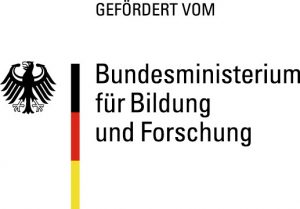Forecasting of the Traffic Situation in the Hannover Region
The main requirement of road traffic participants is to know the current traffic situation. Such data is typically obtained from routing services where the time of many different individual trips is taken into account.
In the context of Data4UrbanMobility tools were developed that allow to predict the traffic situation based on such time series data. The following figure presents an interface to visualize typical time series patterns as well as outliers present in the data:
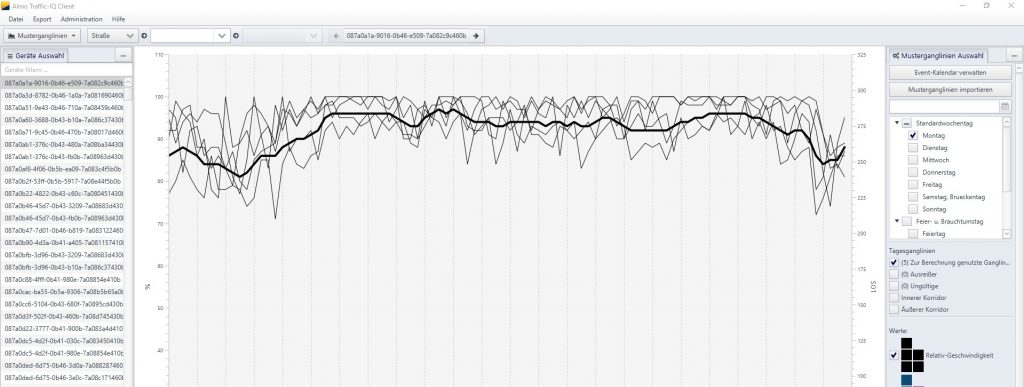
The prediction of the traffic situation is made available in the form of a map based interface for the end user:
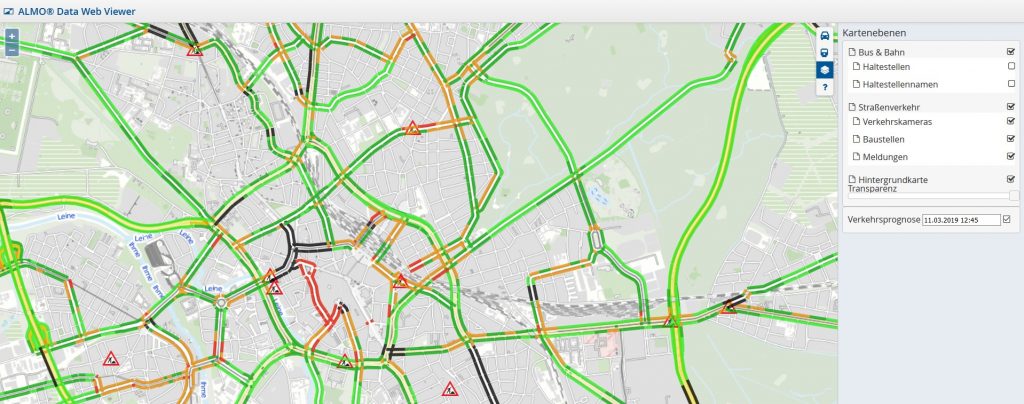
Data4UrbanMobility Data Protection Regulation
The work on the Data4UrbanMobility data protection regulation is completed. The document is publicly available and can be found here.
First Version of MiC-App Available
A first version of the novel MiC-App (Move in the City) App is now available for D4UM-associates as well as a protected group of public users. The mobile MiC-App is a tool to gather data.
MiC was developed by the Institute for Sustainable Urbanism at the University of Braunschweig and the Projektionisten GmbH. MiC links the growing awareness of digital citizen rights with the potential of evaluation big datasets. Therefore MiC gives the opportunity to citizen to actively participate in a citizen science project to take part in the development of the mobility of the feature.
MiC gathers data of the users movement, where the user has the about which data should be recorded. All data is pseudonymised such that the privacy of the contributing citizen is ensured.
Current Status:
In the first version of the app, the user can easily start and end the tracking of his/her movement. It is worth to point out, that the user decides when he is tracked and when not. A summary of his/her activity is available for the user as well as the opportunity to issue feedback or even delete all of his contributed data.
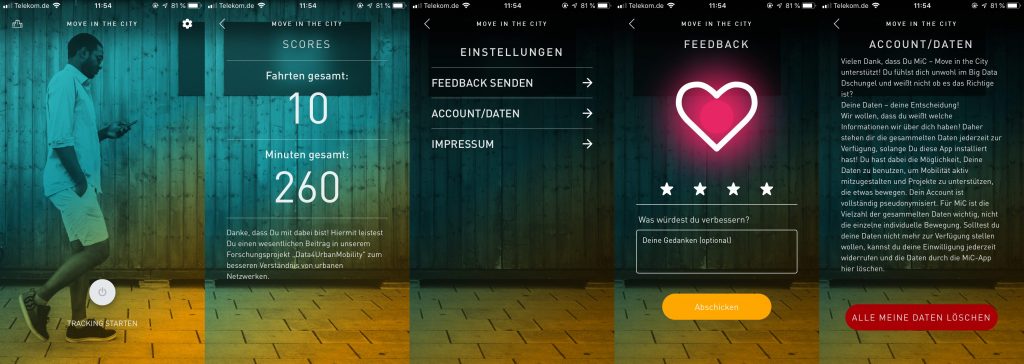
Updated System with Dashboard V2
With the new version of our system, the dashboard will provide even more insights into the impact of public events on the traffic situation.
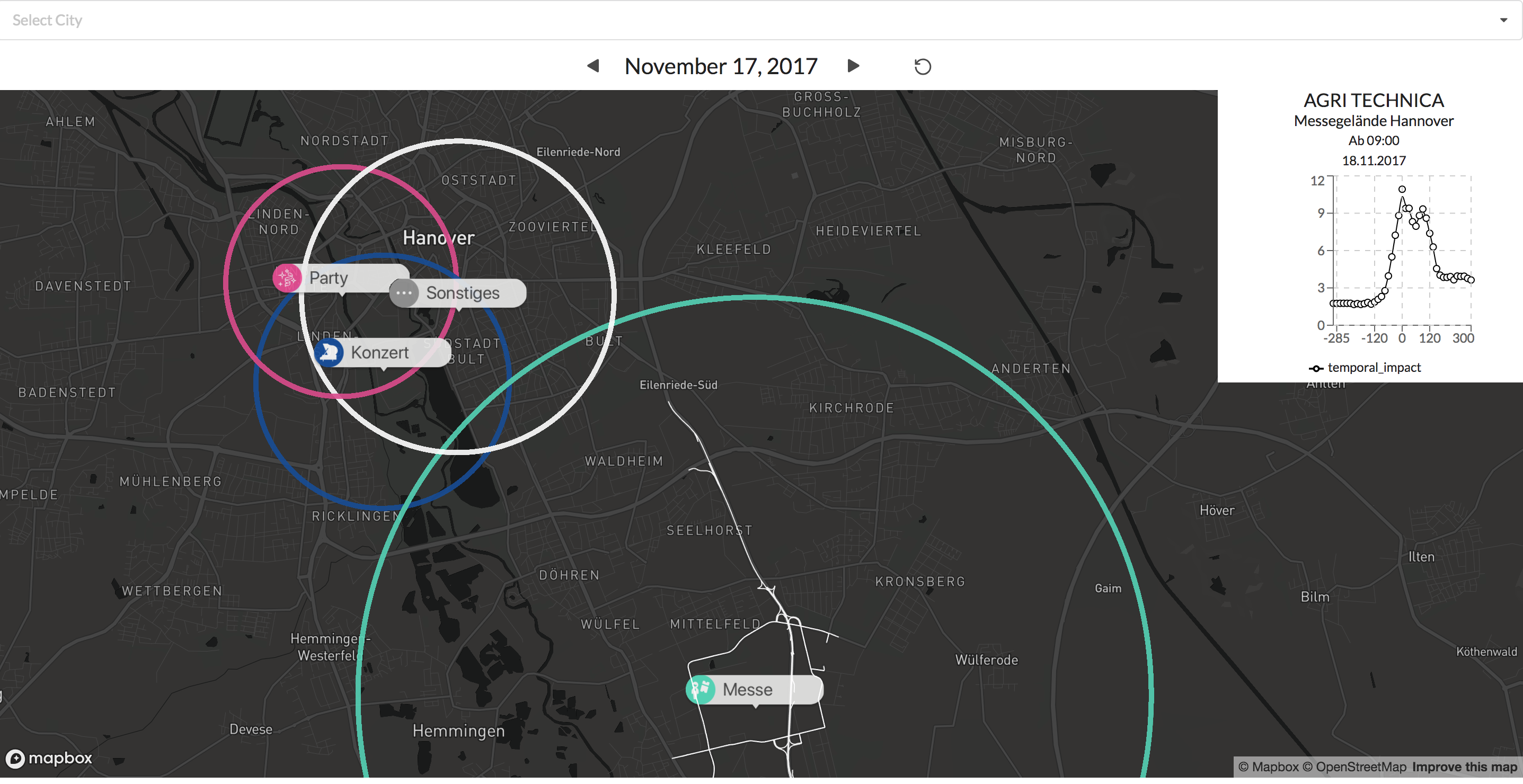
The coloring and labels let us easily distinguish between the different type of events. By clicking on the label we show the typically affected subgraph for that event type. This allows the user to check what specific routes are typically affected by an event at that location.
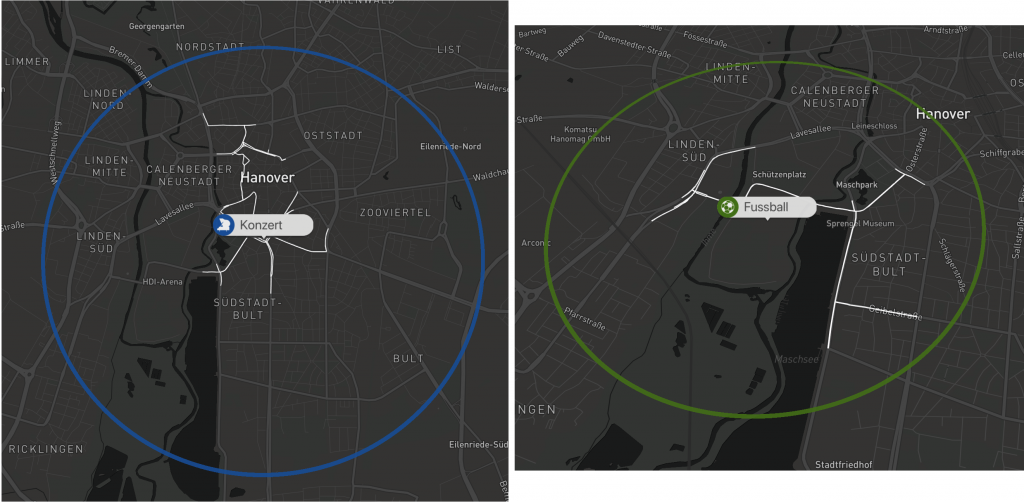
Examples: Visualisation of a concert and a football game.
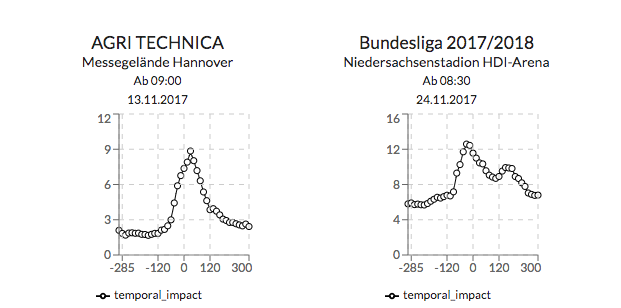
In addition, the graph at the top right gives additional information on how big the impact around the events start time tends to be.
{API}
We enriched the api endpoints with additional information from the data models that were developed as part of the research efforts.
D4UM App Version 1.0
We just released the first Version of the D4UM App. Every project member now has access to the application and can try out its features. Let’s quickly go over some of its main features.
The EFA integration (EFA is a routing engine covering Lower Saxony and Bremen ) allows for quick access to tip information using all available public transport options. Our focus, when designing the application, was on quick and easy navigation to provide a simple and easy to use trip planning tool.
Departures and Connections
On the departure screen we show the user the closes stops for public transportation in his immediate vicinity. On the connection screen the user can fill in his desired starting location( either an address or an existing stop ) and destination and query for what connections are available to him. The provided information contains real time data , meaning we are able to visualized delays for any given connection.
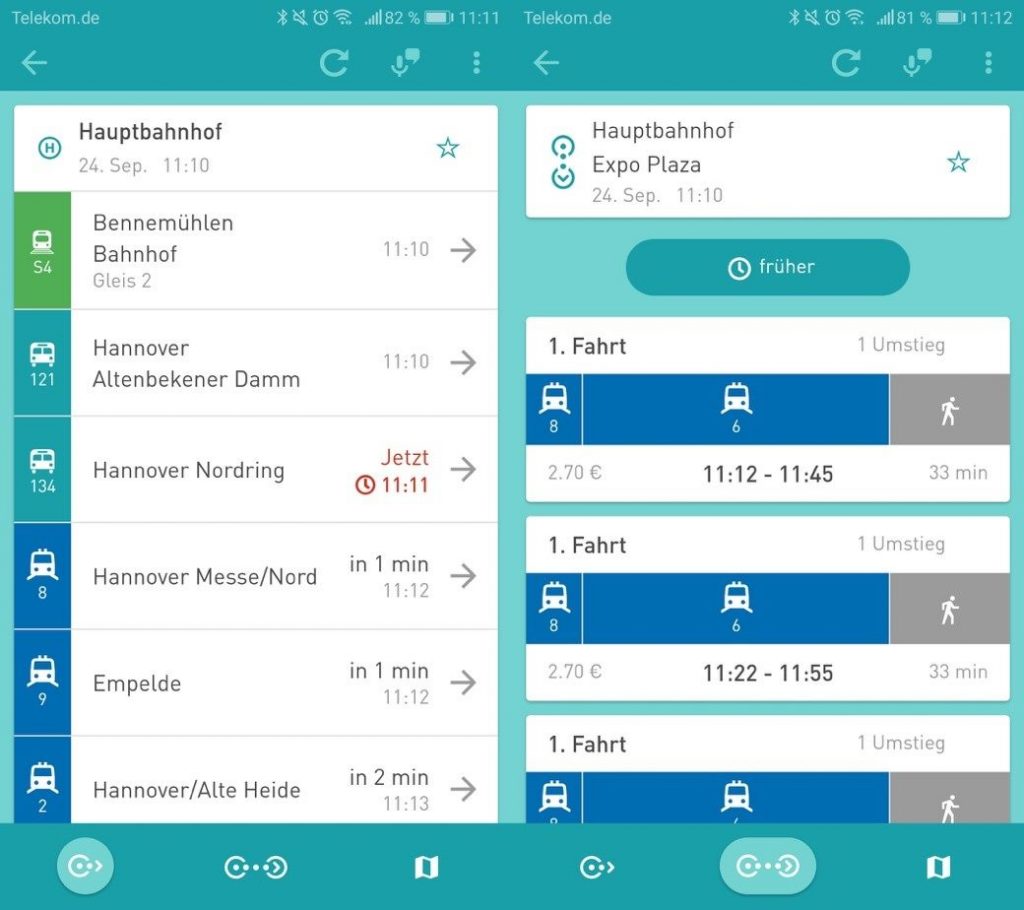
Map
On the map screen you can see and or find all available stops of public transportation. This allows for providing the user with a great way to find out what stops are available in their city. By clicking on any of the shown stops will open the departure screen and provide you with the information mentioned above. To better visualize a selected connection, we show the route you plan to travel on the map.
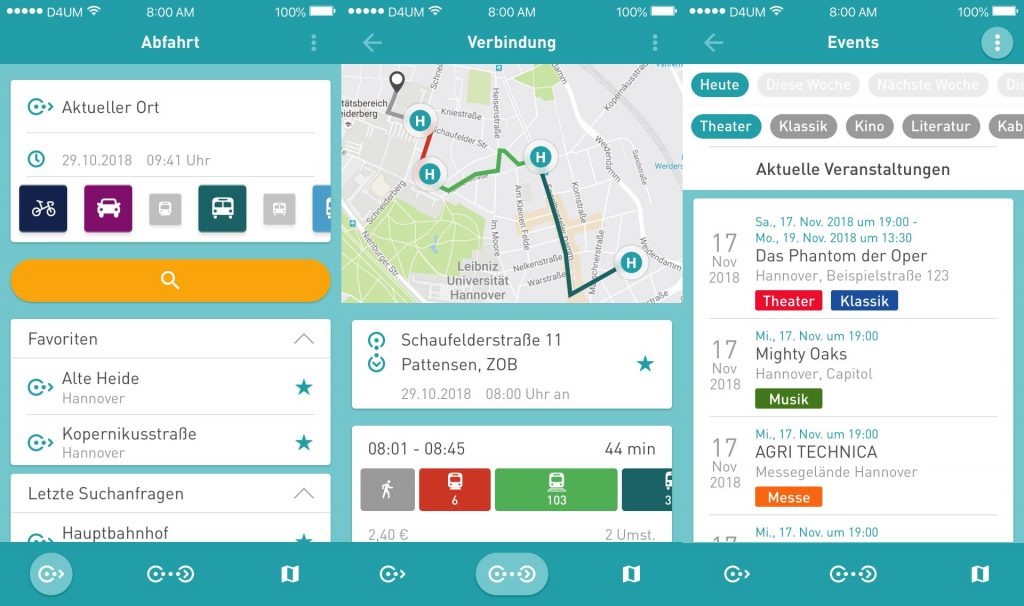
Menu / Settings
Additional features can be found in the settings menu of the application. Here you can find settings that allow you to customize your routing results for both the departures and connection screen. The best way to let us know what you think about the application is to use the feedback module. This can be found here as well. First click on the emoji that best describe how you feel about the app. And then put in any additional information or ideas or thoughts you may have. Now what is left is just to press send and you will send us an email.
We look forward to hearing from you.
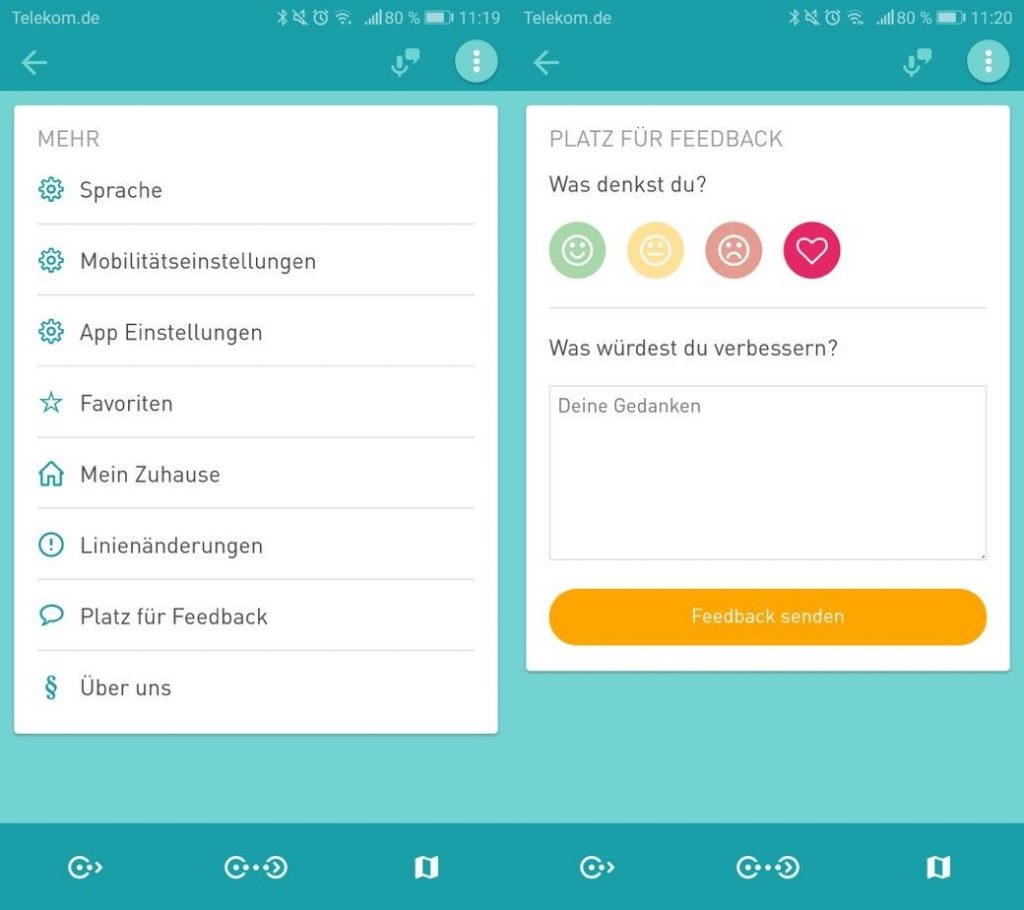
Quantification and Prediction of Impact of Public Events
Current Data4UrbanMobility research results allow for measuring and prediction of spatial impact on road traffic of public events. Connected, affected street segments nearby public events are identified to measure the spatial impact. The approach is depicted in the following figure:

An event is marked as yellow dot, affected streets in red and the measured impact in dark blue. Moreover, an approach making use of machine learning algorithms was developed to predict the impact determined in this way, resulting an error-reduction of up to 40% when compared to existing state-of-the-art approaches.
D4UM – Platform V1 Released
The first version of the Data4UrbanMobiltiy platform has been released. The platform was designed and implemented following a 3-tier-architecture. The platform provides RESTfull Web services for mobility applications like dashboards or mobile apps. As a demonstration, an interactive map application has been developed that visualizes the spatial impact of public events. The following figure shows a screenshot of the application.
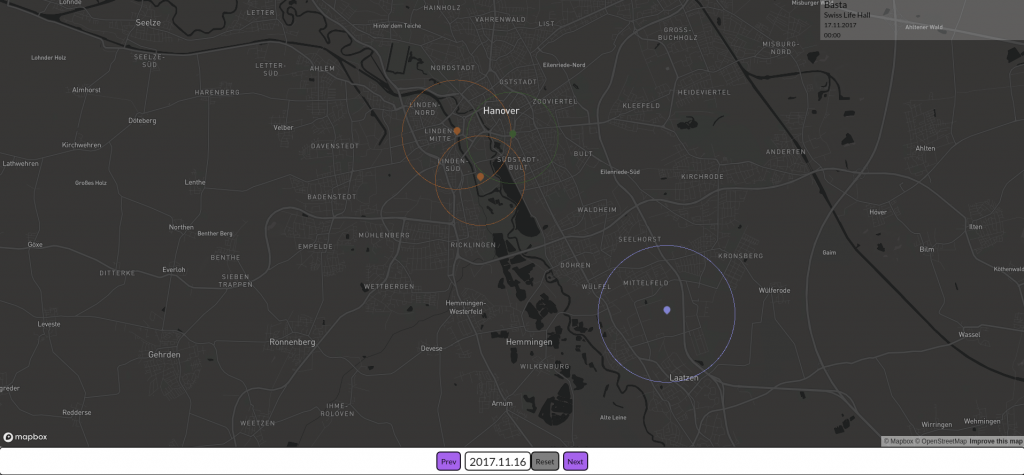
The figure shows 4 public events in the city of Hannover. The colors represent different types of public events (e.g. concerts, fairs, sport events). The circles visualize the spatial impact on road traffic caused by the public events.
Comprehensive Set of Requirements
The Data4UrbanMobility analysis of requirements includes requirements of the application partners Region Hannover (RH) and Wolfsburg AG (WAG) as well as non functional requirements. The requirements were collected by MOMA. The L3S derived research question for data analysis which are based on the requirements of RH and WAG. The research question address especially the information needs of end-users.
The current research questions particularly include
- Automated verification of traffic warnings and prediction of their impact
- Identification of events and prediction of their impact
- Investigation of correlation of road traffic data, public transportation query logs, traffic warnings and twitterfeeds
- Determination of optimal traveling timepoints
Growing Data Collection
ISU create a comprehensive data matrix containing potential source of mobility related data. The Data4UrbanMobility data model describes all project relevant data sets and sets them into context. This makes the data available in a unified manor for both analysis and applications. The selected data sources were transformed according to the Data4UrbanMobility data model by L3S. The data quality of selected data sources (i.e. public transportation query logs and road traffic data) was examined.
Tools for extracting the relevant information from the datasets were developed to enable the integration of the datasets.
- Street and graph extraction from OpenStreetMap
- Bulkloader for public transportation queries
- Integration of “Zentrales Haltestellen Verzeichniss” (central registry of public transportation stops)
The current collection (December 12th 2017) contians
EFA-Logs: 17 million public transportation queries
Road traffic data: 174 thousand street sements with a frequency of 15 minutes
GTFS-data: 90 thousand. public transportation stops, 2.6 thousand routes
Weather: Radolan “Regenraster” (rain grid)
Twitter: 2,5 Mio. Tweets starting at June 2017
OSM: 440 thousand streets
Events: 21 thousand public events (August 14th 2016-July 17th 2018)
Traffic warnings: 13 thousand warning (since June 2017)
Visualization of Public Transportation Information
In order to allow intuitive analytics of public transportation information, the PROJEKTIONISTEN (PROJ) developed a dashboard web application. First prototypes visualize queries addressed to the regional timetable information system EFA (www.efa.de). The prototypes serve as foundations for exploration analyses as well as the implementation of future versions of the dashboard. The following figure shows an integrated visualization of the most frequent origins and destinations of the queries.
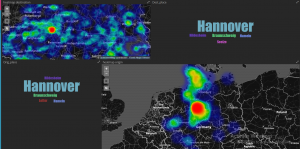
Analysen der EFA-Logs
Analysis of EFA Public Transportation Query Logs
Analyses regarding the impact of public events on public transportation are currently conducted to address early research questions. To this extend, explorative data analyses of the impact of major public events such as football games and medium sized events such as concerts were conducted. Visual analytics were used as a first step towards comprehensive analyses, which show start-like patterns for city center which identify mobility hubs of central importance.
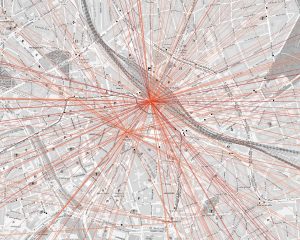
The figure shows the direct connection between origin and destination of public transportation queries. Darker colors correspond to more frequent queried trips. Star-like pattern identify the central train station and the central metro station.
Analyses of single stations reveal weekday dependent patterns.
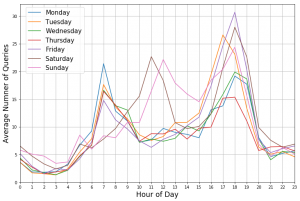
The figure depicts the average number of queries with the destination “Hannover Stadionbrücke”. Differences emerge between Weekends and workdays.
The impact of public events on the queries can be visualized as well.
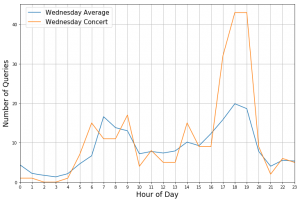
The figure shows the number of queries with the Destination “Hannover Stadionbrücke” for Wednesday, April 26th 2017 (orange) as well as the average number of queries on a Wednesday for the same destination. On this day a concert took place in venue nearby. The concert start at 8 pm. The significant deviations between 5 pm and 7 pm is highly likely to be caused by visitors of the concert. This shows that public transportation queries are a valuable information source to investigate the impact of public events on mobility infrastructure.
Vierter Gleichstellungsbericht. Gleichstellung in der sozial-ökologischen Transformation. Bundesministerium_für_Familie_Senioren_Frauen_und_Jugend (2025). 1–267.
Der Vierte Gleichstellungbericht nimmt die geschlechtsbezogenen Auswirkungen der sozial-ökologischen Wende in den Blick. Der Bericht zeigt, dass der Klimawandel Frauen, einkommensarme und andere strukturell benachteiligte Menschen besonders stark trifft und enthält zahlreiche Handlungsempfehlungen für eine geschlechtergerechte sozial-ökologischen Transformation. Der Vierte Gleichstellungsbericht besteht aus dem Gutachten einer unabhängigen Sachverständigenkommission sowie der Stellungnahme der Bundesregierung zum Gutachten.
PIMSys: A Virtual Prototype for Processing in Memory. Christ, Derek; Jung, Matthias (2025).
Der Technologiewettlauf um Künstliche Intelligenz und seine Pathologien. Butollo, Florian (2025). 78(3) 203–209.
Künstliche Intelligenz (KI) hat sich zu einer Schlüsseltechnologie entwickelt, deren Nutzung sich rapide verbreitet. Der Beitrag zeichnet die Bedeutung von Daten und Rechenleistung und Tendenzen der ökonomischen Konzentration nach, die strukturbildenden Einfluss auf die Weltwirtschaft haben. Aufgrund der bedeutsamen ökonomischen, politischen und militärischen Rolle der KI spitzt sich der Wettlauf um die Kontrolle dieser Technologie weiter zu, wobei er sich einerseits als neue Stufe der Konkurrenz unter großen Tech-Unternehmen und andererseits als geopolitische Frontstellung entfaltet. Der Beitrag benennt die ungleiche Neuordnung der transnationalen Arbeitsteilung, die Machtkonzentration bei Big Tech und die Unterordnung von gemeinwohlorientierten Zielsetzungen gegenüber ökonomischen Interessen als Pathologien dieses Wettlaufs.
A Demonstration of Interstellar Navigation Using New Horizons. Lauer, Tod R.; Munro, David H.; Spencer, John R.; Buie, Marc W.; Gomez, Edward L.; Hennessy, Gregory S.; Henry, Todd J.; Kaplan, George H.; Kielkopf, John F.; May, Brian H.; Parker, Joel W.; Porter, Simon B.; Vrijmoet, Eliot Halley; Weaver, Harold A.; Brandt, Pontus; Singer, Kelsi N.; Stern, S. Alan; Verbiscer, Anne. J.; Acosta, Pedro; Arias, Nicolás Ariel; Babino, Sergio; Ballan, Gustavo Enrique; Buso, Víctor Ángel; Conard, Steven J.; Das Airas, Daniel; Di Scala, Giorgio; Fornari, César; Fraire, Jossiel; Gerard, Brian Nicolás; González, Federico; Goytea, Gerardo; Guzmán, Emilio Mora; Hanna, William; Keel, William C.; Kleiman, Aldo; López, Anselmo; Machuca, Jorge Gerardo; Málaga, Leonardo; Martínez, Claudio; Martinez, Denis; Meliá, Raúl; Monópoli, Marcelo; Murison, Marc A.; Fernandez Pohle, Leandro Emiliano; Ribas, Mariano; Ramón Sánchez, José Luis; Scauso, Sergio; Terrell, Dirk; Traub, Thomas; Valenti, Pedro Oscar; Valenzuela, Ángel; von Hippel, Ted; Chen, Wen Ping; Zambelis, Dennis (2025). 170(1) 22.
As NASA’s New Horizons spacecraft exits the solar system bound for interstellar space, it has traveled so far that the nearest stars have shifted markedly from their positions seen from Earth. We demonstrated this by imaging the Proxima Centauri and Wolf 359 fields from Earth and New Horizons on 2020 April 23, when the spacecraft was 47.1 au distant. The observed parallaxes for Proxima Centauri and Wolf 359 are and , respectively. These measurements are not of research grade, but directly seeing large stellar parallaxes between two widely separated simultaneous observers is vividly educational. Using the New Horizons positions of the two stars alone, referenced to the three-dimensional model (3D) of the solar neighborhood constructed from Gaia DR3 astrometry, further provides the spacecraft spatial position relative to nearby stars with 0.44 au accuracy. The range to New Horizons from the solar system barycenter is recovered to 0.27 au accuracy, and its angular direction to accuracy, when compared to the precise values from NASA Deep Space Network tracking. This is the first time optical stellar astrometry has been used to determine the 3D location of a spacecraft with respect to nearby stars and the first time any method of interstellar navigation has been demonstrated for a spacecraft on an interstellar trajectory. We conclude that the best astrometric approach to navigating spacecraft on their departures to interstellar space is to use a single pair of the closest stars as references, rather than a large sample of more distant stars.
Klimakrise als Glaubenssache – Wie Denkwelten unser Engagement ausbremsen oder unterstützen Gertler, Martin (2025). (1st ed.) BoD – Books on Demand, Hamburg.
Im Zentrum dieser Untersuchung steht die Frage, wie weltanschauliche Denkmodelle (Ökonomismus, Religionismus, Humanismus, Veganismus) anschlussfähig sind an die normativen Anforderungen, die sich aus dem Wissen über die Klimakrise ergeben. Ziel ist es, diese Anschlussfähigkeit nicht nur inhaltlich, sondern auch hinsichtlich ihrer handlungspraktischen und transformativen Potenziale vergleichend zu bewerten. Hierzu wurde ein zweistufiges Bewertungsraster entwickelt: Zum einen basierend auf den strukturellen Anforderungen der Klimawissenschaft, zum anderen auf Kriterien normativer Wirksamkeit und Engagementfähigkeit. Die Analyse erfolgte theoriebasiert, qualitativ und textanalytisch anhand ausgewählter repräsentativer Texte, bezogen auf den deutschsprachigen Raum. Die Untersuchung zeigt, dass weltanschauliche Denkmodelle die Wahrnehmung und Bewertung klimapolitischer Anforderungen in spezifischer Weise strukturieren. Während das ökonomistische Denkmodell in politischen Programmen dominiert, zeigen alternative normative Leitbilder (Humanismus, Veganismus) ein höheres Potenzial für systemische Reflexion und transformative Handlungsmotivation. Die exemplarische Anwendung des Rasters auf den Koalitionsvertrag der Bundesregierung 2025 macht deutlich, dass politische Programme implizite weltanschauliche Rahmungen aufweisen und wie diese Rahmungen maßgeblich die Ausrichtung und Tiefe klimapolitischer Maßnahmen beeinflussen. Es wird erkennbar, dass die Analyse weltanschaulicher Modelle einen zentralen Beitrag zur Gestaltung und Kommunikation transformativer Klimapolitik leisten kann. Sie bietet Anknüpfungspunkte für die Praxis, insbesondere in den Bereichen Bildung, politische Kommunikation und zivilgesellschaftliche Allianzen. Weiterführende Forschung könnte das entwickelte Raster empirisch validieren, auf andere gesellschaftliche Dokumente anwenden oder international vergleichend erweitern. Klimapolitische Transformation ist nicht nur eine technische oder wirtschaftliche Herausforderung, sondern findet ebenso kulturell, normativ und weltanschaulich statt. Die nun erarbeitete systematische Analyse weltanschaulicher Transformationsfähigkeit eröffnet somit neue Perspektiven für die Bewältigung der Klimakrise in Theorie, Praxis und Bildung.
Migraine Pain Data -A Submission to the Bring Your Own Biodata (BYOB) Workshop at DIS’25. Friedenberger, Tamara (2025).
Gender Barriers, Structural Transformation, and Economic Development. Chiplunkar, Gaurav; Kleineberg, Tatjana (World_Bank_Group, ed.) (2025). (Policy Research Working Paper 11083) 1–67.
Auf der Grundlage repräsentativer Daten aus mehr als 90 Ländern werden in diesem Papier geschlechtsspezifische Muster bei Beschäftigungsübergängen dokumentiert. Das Papier verwendet ein Strukturmodell für die Berufs- und Sektorwahl mit Fokus auf sechs große Volkswirtschaften. Dabei werden Gender Barrieren betrachtet, also geschlechtsspezifische Verzerrungen bei Beschäftigung und Löhnen. Abnehmende Gender Barrieren sind ein Hauptfaktor für den beobachteten Anstieg der weiblichen Erwerbsbeteiligung, die Expansion des Dienstleistungssektors und den Anstieg des realen BIP pro Kopf von 1970 bis 2018. Dabei allerdings mit erheblichen Unterschieden zwischen den Ländern.
Enhancing Offline Reinforcement Learning with Curriculum Learning-Based Trajectory Valuation. Abolfazli, Amir; Song, Zekun; Anand, Avishek; Nejdl, Wolfgang in AAMAS ’25 (2025). 5–13.
The success of deep reinforcement learning (DRL) relies on the availability and quality of training data, often requiring extensive interactions with specific environments. In many real-world scenarios, where data collection is costly and risky, offline reinforcement learning (RL) offers a solution by utilizing data collected by domain experts and searching for a batch-constrained optimal policy. This approach is further augmented by incorporating external data sources, expanding the range and diversity of data collection possibilities. However, existing offline RL methods often struggle with challenges posed by non-matching data from these external sources. In this work, we specifically address the problem of source-target domain mismatch in scenarios involving mixed datasets, characterized by a predominance of source data generated from random or suboptimal policies and a limited amount of target data generated from higher-quality policies. To tackle this problem, we introduce Transition Scoring (TS), a novel method that assigns scores to transitions based on their similarity to the target domain, and propose Curriculum Learning-Based Trajectory Valuation (CLTV), which effectively leverages these transition scores to identify and prioritize high-quality trajectories through a curriculum learning approach. Our extensive experiments across various offline RL methods and MuJoCo environments, complemented by rigorous theoretical analysis, demonstrate that CLTV enhances the overall performance and transferability of policies learned by offline RL algorithms.
The Influence of Avatar Visual Fidelity on Embodiment and User Experience in Virtual Reality. Hartfill, Judith; Bormann, Frederico; Wolf, Erik; Steinicke, Frank (2025).
Discuss How AI and ML Can Optimize Lifecycle Management Practices within Pharmaceutical Companies fromDevelopment to Post-Market Surveillance. Vellanki, Jahnavi (J. Vellanki, ed.) (2025). 15(3) 11.
The pharma industry is in the midst of a digital revolution, with Artificial Intelligence (AI) and Machine Learning (ML) becoming potent tools to streamline lifecycle management at every stage—right from early drug discovery to post-market surveillance. This paper seeks to critically evaluate how AI and ML technologies are transforming pharma processes by enhancing efficiency, accuracy, decision-making, and patient outcomes. We discuss the use of predictive algorithms in target identification, artificial intelligence-based simulations in clinical trial design, machine-based compliance monitoring in manufacturing, and real time analytics in pharmacovigilance. The focus is on the convergence of emerging technologies like blockchain, which complements data transparency and security when integrated with AI platforms. Although the promise of these technologies is enormous, the paper also discusses ongoing challenges such as data silos, algorithmic bias, and regulatory barriers. This research integrates current literature to present a unified perspective of AI and ML applications in pharma, detailing future directions and industry implications. Finally, the findings emphasize that although AI is no silver bullet, its strategic implementation can significantly enhance lifecycle efficiency and innovation in drug development.
Mitbestimmung und Partizipation 2030: Demokratische Perspektiven auf Arbeit und Beschäftigung Wannöffel, Manfred; Niewerth, Claudia; Hoose, Fabian; Urban, Hans-Jürgen (2025). (1. Auflage ) Nomos, Baden-Baden.
Zum 50. Jubiläum des Kooperationsvertrages zwischen der Ruhr-Universität Bochum und der IG Metall nimmt der Sammelband die Zukunft von Mitbestimmung und Partizipation in den Blick. Im Zentrum steht die Frage, wie sich demokratische Gestaltungsmöglichkeiten in Zeiten tiefgreifender wirtschaftlicher und gesellschaftlicher Umbrüche weiterentwickeln. Demokratie in Gesellschaft und Politik ist auf eine lebendige Demokratisierung der Arbeitswelt angewiesen – ohne Mitbestimmung in Betrieben und Unternehmen verliert sie ihre soziale Verankerung und Stabilität. Die Beiträge reflektieren historische Entwicklungen, analysieren aktuelle Herausforderungen und diskutieren innovative Ansätze für die Weiterentwicklung von Mitbestimmung und Partizipation.
Classification of Network Traffic using Machine Learning Models on the NetML Dataset. Messaoud, Mezati (N. Meghanathan, ed.) (2025). 17(3)
Network traffic classification plays a critical role in cybersecurity, quality of service (QoS) management, and anomaly detection. Traditional rule-based classification methods struggle with the increasing complexity and volume of network traffic, necessitating the adoption of machine learning (ML) techniques. In this study, we explore the effectiveness of ML models in classifying network traffic using the NetML dataset, a benchmark dataset that captures diverse traffic patterns, including benign and malicious activities. We preprocess the dataset by applying feature selection, normalization, and data balancing techniques to optimize model performance. Several ML models, including traditional classifiers such as Random Forest (RF), Support Vector Machines (SVM), and K-Nearest Neighbors (KNN), as well as deep learning models such as Convolutional Neural Networks (CNN) and Long Short-Term Memory (LSTM) networks, are trained and evaluated. Model performance is assessed using accuracy, precision, recall, F1- score, and AUC-ROC metrics. Experimental results demonstrate that deep learning models, particularly LSTM networks, achieve superior performance in capturing temporal dependencies in network traffic, significantly outperforming traditional classifiers. Our results indicate that LSTM, GRU, and CNN models all achieved an accuracy of 92.26%, highlighting their effectiveness in network traffic classification. Additionally, feature selection techniques improved computational efficiency without compromising classification performance. However, confusion matrix analysis revealed that the models tend to predict the most frequent class, leading to potential bias and lower accuracy for minority classes. The study also highlights the presence of high values in the confusion matrices, exceeding 70,000 in some cases, indicating dataset imbalance and model bias toward dominant classes. Despite achieving high accuracy, misclassification challenges persist, particularly in identifying encrypted traffic and polymorphic attacks. Transformer-based models demonstrated resilience to adversarial modifications but required significantly higher computational resources. Future work should explore adversarial training, self-supervised learning, and hybrid CNN-LSTM architectures to enhance robustness against evolving cyber threats. Additionally, feature selection optimization and hyperparameter tuning can further refine classification performance, ensuring more reliable deployment in real-world cybersecurity applications.
PIMSys: A Virtual Prototype for Processing in Memory. Christ, Derek; Jung, Matthias (2025).
Modeling and Simulating Emerging Memory Technologies: A Tutorial. Chen, Yun-Chih; Seidl, Tristan; Hölscher, Nils; Hakert, Christian; Truong, Minh Duy; Chen, Jian-Jia; de Lima, João Paulo C.; Khan, Asif Ali; Castrillon, Jeronimo; Nezhadi, Ali; Siddhu, Lokesh; Nassar, Hassan; Mayahinia, Mahta; Tahoori, Mehdi Baradaran; Henkel, Jörg; Wilbert, Nils; Wildermann, Stefan; Teich, Jürgen (2025).
Modeling and Simulating Emerging Memory Technologies: A Tutorial. Chen, Yun-Chih; Seidl, Tristan; Hölscher, Nils; Hakert, Christian; Truong, Minh Duy; Chen, Jian-Jia; de Lima, João Paulo C.; Khan, Asif Ali; Castrillon, Jeronimo; Nezhadi, Ali; Siddhu, Lokesh; Nassar, Hassan; Mayahinia, Mahta; Tahoori, Mehdi Baradaran; Henkel, Jörg; Wilbert, Nils; Wildermann, Stefan; Teich, Jürgen (2025).
Datenschutz in der digitalen Arbeitswelt: das Beispiel Plattformarbeit. Mangold, Sonja (2025). (3) 261–278.
Linguistic capacity was present in the Homo sapiens population 135 thousand years ago. Miyagawa, Shigeru; DeSalle, Rob; Nóbrega, Vitor Augusto; Nitschke, Remo; Okumura, Mercedes; Tattersall, Ian (2025). 16 1503900.
Recent genome-level studies on the divergence of early Homo sapiens, based on single nucleotide polymorphisms, suggest that the initial population division within H. sapiens from the original stem occurred approximately 135 thousand years ago. Given that this and all subsequent divisions led to populations with full linguistic capacity, it is reasonable to assume that the potential for language must have been present at the latest by around 135 thousand years ago, before the first division occurred. Had linguistic capacity developed later, we would expect to find some modern human populations without language, or with some fundamentally different mode of communication. Neither is the case. While current evidence does not tell us exactly when language itself appeared, the genomic studies do allow a fairly accurate estimate of the time by which linguistic capacity must have been present in the modern human lineage. Based on the lower boundary of 135 thousand years ago for language, we propose that language may have triggered the widespread appearance of modern human behavior approximately 100 thousand years ago.
The Lost Large Mammals of Arabia. Clarke, Christopher; Alsharif, Sultan M (2025). 1–48.
Aim: If successful, plans to restore the vegetation of the Arabian Peninsula (AP) as announced by the Middle East and Saudi Green Initiatives will see the greatest increase in vegetation cover since the beginning of the Holocene Humid Phase (HHP), roughly 9–10,000 years ago. This marked an expansion in human population that was followed by animal extinctions and extirpations that have been accelerating to the present day. The re-greening of Arabia presents a major opportunity to reverse much of this species decline; yet no complete list of the large mammal fauna of the AP during the Holocene has ever been published.
Continued Rapid Radio Brightening of the Tidal Disruption Event AT2018hyz. Cendes, Yvette; Berger, Edo; Beniamini, Paz; Gill, Ramandeep; Matsumoto, Tatsuya; Alexander, Kate D.; Bietenholz, Michael F.; Hajela, Aprajita; Christy, Collin T.; Chornock, Ryan; Gomez, Sebastian; Gurwell, Mark A.; Keating, Garrett K.; Laskar, Tanmoy; Margutti, Raffaella; Rao, Ramprasad; Velez, Natalie; Wieringa, Mark H. (2025).
We present ongoing radio observations of the tidal disruption event (TDE) AT2018hyz, which was first detected in the radio at 972 days after disruption, following multiple non-detections from earlier searches. The new observations presented here span approximately 1370-2160 days and 0.88-240 GHz. We find that the light curves continue to rise at all frequencies during this time period, following a power law of about F ~ t^3 (compared to F_nu ~ t^5.7 at 972-1400 days), and reaching a peak luminosity of L~ 10^40 erg/s, comparable to the luminosity of the relativistic TDE Swift 1644+57 on the same timescale. The multi-frequency data indicate that the peak frequency does not significantly evolve over the 1030-day span of our observations, while the peak flux density increases by an order of magnitude. The observed behavior is consistent with two possible scenarios: (i) a delayed spherical outflow launched about 620 days post-disruption with a velocity of ~0.3c and an energy of ~10^50 erg, and (ii) a highly off-axis (~80-90 deg) relativistic jet with a Lorentz factor of Gamma ~8 and E_K ~ 10^52 erg. Continued radio observations to capture the light curve peak, as well as VLBI observations, could distinguish between these scenarios.
M.C. Escher’s Word-Puzzle Wrapping Paper for De Bijenkorf. Schattschneider, Doris T. Verhoeff, D. Swart, S. L. Gould, E. Torrence (eds.) (2025). 411–414.
In 1933, M.C. Escher designed gift-wrapping paper for the De Bijenkorf department store. He described it as a “word puzzle”; it is a puzzle to solve how it was produced from a small woodblock.
LACII: Enhancing Decision-Making in Business Processes with the IIoT: A Cognitive Load Aware Design Approach. Nebel, Maximilian; Ciftci, Seyyid A.; Janiesch, Christian G. Fortino, M. Mecella (eds.) (2025).
AI-Enabled Platforms: Exploring Strategic Value Creation through a Strategy-as-Practice Lens. Schadl, Adrian; Mahei Manhai, Li; Janson, Andreas; Schäfer, Björn (2025).
Platform organizations are pioneering the development and adoption of artificial intelligence (AI), yet AI poses substantial challenges by disrupting organizational capabilities and threatening competitive advantages. AI reshapes processes and products, influences ecosystem coordination, and foster inter-departmental collaboration. Recognizing its potential, businesses invest heavily in AI, but numerous applications fail to deliver significant value. Surprisingly, even though AI’s influence spans internal and external functions and capabilities, most studies focus on specific contexts and rarely examine the actual business outcomes of AI applications. This paper studies the empirical impact of AI on platform organizations’ value creation. Thus, we adopt a multi-study approach grounded in a Strategy-as-Practice perspective, investigating how AI integration transforms strategic practices. Study 1 draws on currently 45 interviews with platform organizations and develops a holistic framework that classifies AI applications according to their internal and external value creation and focus, enabling us to understand AI’s organizational impact on platform value-creation mechanisms. Study 2 will employ an event-study method and aims to assess the shareholder value impacts of these applications, empirically demonstrating AI’s business value. Preliminary insights from Study 1 indicate that platforms use AI to develop innovation platforms, introduce novel services, optimize ecosystem orchestration, and foster co-creation. By offering a holistic perspective on AI applications and empirically linking practices to shareholder value, this research contributes to both theory and practice. It clarifies how AI can function as a strategic capability within platform organizations, extending our understanding of micro-level strategic practices while guiding managers seeking to realize AI’s potential.
Real-World Testing Matters in Reinforcement Learning for Education. Riedmann, Anna; D’Eramo, Carlo; Lugrin, Birgit (2025). 1764–1773.
Reinforcement Learning in Education: A Systematic Literature Review. Riedmann, Anna; Schaper, Philipp; Lugrin, Birgit (2025).
Graph Neural Networks for Grid Control: Prospects in AI-assisted Transmission Grid Operation. Holzhüter, Clara Juliane; Lytaev, Pawel; Dipp, Marcel; Hassouna, Mohamed; Brendlinger, Kurt; Viebahn, Jan; Gegelman, Wiktor; Merz, Christian (2025). 874–881.
Transmission grid congestion management and outage planning are critical tasks in modern grid operation due to thenon-linear nature of power flows and the large-scale optimization challenges faced by operators. Traditionally, overloadsare addressed through generator redispatch, a costly and therefore suboptimal measure. In the project "Graph NeuralNetworks for Grid Control" (GNN4GC), we investigate alternative strategies, focusing on topological remedial actionsthat could minimize or even completely eliminate redispatch costs. Topology optimization, a core aspect of this project,presents significant challenges due to its combinatorial nature, requiring extensive computational resources for powerflow calculations. To address this, GNN4GC is split into three stages. In the first stage, we explore the use of GraphNeural Networks (GNNs) to accelerate these calculations and benchmark their performance against established tools likepandapower and a DC power flow solver developed by 50Hertz Transmission GmbH and TenneT TSO GmbH. In thesecond stage, we use Reinforcement Learning and other heuristics to select suitable topologies and solve the topologyoptimization problem. As a third stage, we test the respective agent on real-life grids to benchmark the methodology. Theaim of the final stage is to build a recommender system that can be used in a control room in the future.
Fostering Pre-service Teachers’ Media Education Competence: A Pedagogical Concept for Initial Teacher Education. Hahn, Jannis; Tiede, Jennifer; Grafe, Silke (2025).
Current advancements in the media landscape significantly impact adolescents’ development. Implementing media education in initial teacher education programs is essential for promoting pre-service teachers’ competence to foster their future students’ media literacy. In this study, we assess whether the objectives of a theory- and practice-based pedagogical concept to promote pre-service teachers’ media education competence have been reached. This represents the second iteration of a design-based research study, in which the first version of the pedagogical concept is further refined and implemented at a German university. In an empirical evaluation at pre- and post-intervention measurement points, a convenience sample of 38 pre-service teachers was presented with competence-based tasks. Responses were analyzed for differences in achieving media education competence based on the consideration of competence standards. Two consecutive levels of analysis were used, including a qualitative content analysis followed by a Wilcoxon signed-rank test. Findings indicate that participants showed significant improvements in referring to empirical findings related to adolescents’ media use, discussing theoretical approaches to media education, and evaluating these approaches and examples for media education activities from different perspectives. Based on these results, implications for further research on theory- and practice-based curriculum development in higher education are provided.
m(6)A in the coding sequence: linking deposition, translation, and decay. Ćorović, Miona; Hoch-Kraft, Peter; Zhou, You; Hallstein, Sarah; König, Julian; Zarnack, Kathi (2025). S0168–9525(25)00132.
N6-methyladenosine (m(6)A) is the most abundant internal modification in mRNA and plays a crucial role in regulating mRNA turnover. This review explores the characteristics of m(6)A sites in the coding sequence (CDS) and their influence on mRNA decay, with a focus on the newly discovered CDS-m(6)A decay (CMD) pathway - a translation-dependent mechanism that promotes rapid and efficient degradation. Further, we examine how splicing-associated factors influence m(6)A deposition and discuss the enrichment of CMD targets in processing bodies (P-bodies). We emphasize the interplay between m(6)A modification and decay, and propose that targeting the CMD pathway could offer novel therapeutic strategies for diseases such as cancer and metabolic disorders.
Climate change risks on key open marine and coastal mediterranean ecosystems. Hassoun, Abed El Rahman; Mojtahid, Meryem; Merheb, Mohammad; Lionello, Piero; Gattuso, Jean-Pierre; Cramer, Wolfgang (2025). 15(1) 24907-.
Mediterranean open marine and coastal ecosystems face multiple risks that impact their unique biodiversity, with climate change representing a major ongoing threat. While these ecosystems are also under pressure from non-climatic anthropogenic drivers (e.g., overfishing, pollution), this study primarily focuses on risks related to climate change. To assess these risks and evaluate their confidence levels, we adopt the scenario-based approach of the Intergovernmental Panel on Climate Change (IPCC), relying on a review of literature projecting changes in Mediterranean Sea ecosystems. The main drivers of environmental change are sea level rise, ocean warming and acidification. Similar to global conditions, all Mediterranean ecosystems face high risks under all climate scenarios, with coastal ecosystems being more strongly impacted than open marine ecosystems. For these coastal ecosystems, risk levels are expected to become very high already once global warming exceeds 0.8 °C with respect to the 1976–2005 period. A few Mediterranean ecosystems (e.g., coralligenous and rocky coasts) are relatively more resilient compared to others, probably because of their long evolutionary history and the presence of a variety of climatic and hydrological conditions. However, high-emission scenarios in specific sub-basins, in addition to acidification impacts, could reduce this resilience, decreasing both habitat extent and ecosystem function dramatically. Overall, due to the higher observed and projected rates of climate change in the Mediterranean, compared to global trends, for variables such as seawater temperature and pH, marine ecosystems (particularly coastal) are projected to be under higher risks compared to the global ocean.
An Overview of Microprocessors and Assembly Language Programming. Zaman, Md. Abdullah Al; Monira, Nusrath Jahan (2025).
Kontrollaversion und Entlastungsoptimismus in vernetzten Kliniken: Diagnosen der Autonomie und der Mitbestimmung in der akutstationären Pflege. Technical Report (374), Bringmann, Julia; Petersen, Benjamin Henry; Staab, Philipp (2025).
Wie verändern datenintensive Softwaresysteme die Arbeit in der Pflege? Die Studie "Kontrollaversion und Entlastungsoptimismus in vernetzten Kliniken" untersucht, wie sich Digitalisierung und Teilautomatisierung auf die Autonomie von Pflegekräften und die betriebliche Mitbestimmung auswirken. Die Ergebnisse zeigen: Trotz erweiterter technischer Kontrollmöglichkeiten bleibt die Handlungsfreiheit der Pflegekräfte weitgehend erhalten. Ausgehend von einer institutionalisierten und betrieblich gelebten Kontrollaversion eröffnen sich für die Mitbestimmung neue Handlungsspielräume, deren gemeinsamer Fluchtpunkt die Entlastung der Pflegekräfte durch die digitalisierungsinduzierte Optimierung des Arbeitsprozesses ist.
Neue Arbeitswelt in der Fleischindustrie? Eine Bilanz der Veränderungen nach dem Arbeitsschutzkontrollgesetz. Erol, Serife; Schulten, Thorsten (Wirtschafts_und_Sozialwissenschaftliches_Institut, ed.) (2025). (WSI Study Nr. 41) 1–92.
Die Fleischindustrie stand lange wegen prekärer Arbeitsbedingungen in der Kritik. Mit dem Arbeitsschutzkontrollgesetz von 2021 wurden Werkverträge und Leiharbeit verboten, um Beschäftigte besser zu schützen. Doch wie hat sich die Situation seitdem entwickelt? Unsere Untersuchung analysiert die Auswirkungen des Gesetzes auf Arbeits-, Beschäftigungs- und Partizipationsbedingungen sowie -beziehungen - von Verbesserungen bis zu neuen Herausforderungen. Hat die Reform ihr Ziel erreicht oder sind neue Probleme entstanden? Die Untersuchung gibt Einblicke in eine Branche im Wandel und zieht eine Zwischenbilanz der Veränderungen nach dem Arbeitsschutzkontrollgesetz.
Die Zukunft der Arbeit. Forschungserkenntnisse und Impulse für die Gestaltung der Arbeitswelt Fachbeiträge aus dem 70. Frühjahrskongress der Gesellschaft für Arbeitswissenschaft e.V. Jurecic, Mitja (2025). 1–38.
Die Arbeitswelt befindet sich in einem Wandel, geprägt von hybriden Arbeitsmodellen, technologischen Fortschritten und dem wachsenden Bedarf an flexiblen, zukunftsorientierten Bürokonzepten. Dieser Sammelband fasst ausgewählte Forschungsergebnisse des Frühjahreskongresses zusammen und behandelt Themen wie zeitliche und örtliche Flexibilität, Workation, die Bedeutung von Büroinfrastruktur und Anwesenheit, digitale Kompetenzen sowie die Gestaltung hybrider und nachhaltiger Arbeitsumgebungen. Die Beiträge liefern wissenschaftliche Erkenntnisse und praxisnahe Ansätze, um die Arbeitswelt zu gestalten und dabei Produktivität, Wohlbefinden und Innovationskraft zu fördern.
Internationale Arbeits- und Bürokultur. Ansätze und Praktiken im globalen Vergleich. Pan, Yue; Yurdakul-Ziegler, Meral; Jurecic, Mitja; Rief, Stefan (2025). 1–24.
In einer globalisierten Arbeitswelt gewinnen internationale Arbeits- und Bürokulturen zunehmend an Bedeutung. Diese Studie beleuchtet zentrale Aspekte wie Arbeitszeitmodelle, Homeoffice-Regelungen, Pausengestaltung und Meetingkultur in verschiedenen Ländern. Sie zeigt auf, wie kulturelle Unterschiede - etwa zwischen dem arbeitsintensiven 996-Modell in der chinesischen Tech-Industrie und der zunehmenden Verbreitung der 4-Tage-Woche in Europa - die Arbeitsrealität prägen. Der Einfluss der Corona-Pandemie auf hybride Arbeitsmodelle und die regional variierende Akzeptanz von Homeoffice werden ebenfalls analysiert.
Soziale Sicherung in der Plattformökonomie: Analysen, Befunde und Regulierungsansätze. Hoose, Fabian; Beckmann, Fabian; Topal, Serkan; Glanz, Sabrina (Institut_Arbeit_und_Qualifikation_Universität_Duisburg_Essen, ed.) (2025). (IAQ-Forschung 2025/02) 1–16.
Der vorliegende Abschlussbericht entstand im Rahmen des Forschungsprojektes „Plattformökonomie und soziale Sicherung: Arbeits- und Sicherungsorientierungen digitaler Selbstständiger zwischen De- und Re-Institutionalisierung“. Das Kooperationsprojekt zwischen dem Institut Arbeit und Qualifikation der Universität Duisburg-Essen und der gemeinsamen Arbeitsstelle RUB/IGM der Ruhr-Universität Bochum wurde über einen Zeitraum von drei Jahren (2021 – 2024) im Rahmen des Fördernetzwerks Interdisziplinäre Sozialpolitikforschung (FIS) des Bundesministeriums für Arbeit und Soziales gefördert.
Gate-defined Kondo lattices with valley-helical quantum dot arrays. Manesco, Antonio L. R. (2025). 19 024.
Kondo physics and heavy-fermion behavior has been predicted and observed in moiré materials. The electric tunability of moiré materials allows an in-situ study of Kondo lattices' phase diagrams, which is not possible with their intermetallic counterparts. However, moiré platforms rely on twisting, which introduces twisting angle disorder and undesired buckling. Here we propose device layouts for one- and two-dimensional gate-defined superlattices in Bernal bilayer graphene where localized states couple to dispersive valley-helical modes. We show that, under electronic interactions, these superlattices are described by an electrically-tunable Kondo-Heisenberg model.
Digital Trade Unionism Toolkit. European_Trade_Union_Confederation (2025). 1–30.
In einer Zeit des technologischen Fortschritts und der sich verändernden sozioökonomischen Landschaft befinden sich die Gewerkschaften an einem kritischen Punkt. Traditionelle Wege funktionieren nicht mehr so gut wie früher. Strukturen und Methoden, die einst die Effektivität untermauerten, werden durch eine Vielzahl von Faktoren in Frage gestellt, was eine tiefgreifende Neubewertung der bisherigen Strategien und Ansätze erforderlich macht. Der Ruf nach digitaler Gewerkschaftsarbeit ist heute dringlicher und wichtiger denn je. Dieses Toolkit soll den nationalen Gewerkschaften helfen, mit der digitalen Welt umzugehen, ihre Mitgliederzahl zu erhöhen und an ihren Grundwerten festzuhalten.
Organized Labor Versus Robots? Evidence from Micro Data. Findeisen, Sebastian; Dauth, Wolfgang; Schlenker, Oliver (Leibniz_Zentrum_für_Europäische_Wirtschaftsforschung, ed.) (2025). (ZEW Discussion Paper Nr. 25-005) 1–48.
In dieser Studie wird untersucht, wie insbesondere betriebliche Mitbestimmung durch Betriebsräte die Auswirkungen von Automatisierung und neuer Technologien beeinflussen. Es wird gezeigt, dass Betriebsräte das Kündigungsrisiko für bestehende Arbeitnehmer*innen insbesondere von älteren Beschäftigten während Automatisierungsprozessen verringern. Schließlich zeigen die Ergebnisse, dass Betriebsräte die Einführung von Robotern nicht verhindern, sondern vielmehr den Einsatz hochwertigerer Roboter fördern, verstärkte Weiterbildungsmaßnahmen während der Automatisierung anregen und langfristig ein höheres Produktivitätswachstum begünstigen.
Bots im Büro. Künstliche Intelligenz und der Wandel von Angestelltenarbeit in der digitalen Transformation. Lühr, Thomas; Kämpf, Tobias (Hans-Böckler-Stiftung, ed.) (2025). (494) 1–100.
Mit der digitalen Transformation kommt es zu einem Schub in der Automatisierung von Arbeit. Die Einführung von Künstlicher Intelligenz führt zur grundlegenden Restrukturierung der Arbeitsinhalte und -prozesse im Büro. Damit gehen nicht nur Risiken von Funktionsverlusten bis hin zum Verlust des Arbeitsplatzes einher, sondern auch neue Machtpotenziale. Diese prägen das Bewusstsein der Angestellten wesentlich. Künstliche Intelligenz funktioniert nicht ohne Mitbestimmung - mit Mitbestimmung ergeben sich neue Ansatzpunkte für eine arbeitspolitische Vorwärtsstrategie. Die vorliegende Studie nimmt eine empirisch gestützte Analyse der Potenziale vor, die der Automatisierungsschub für die Beschäftigten und ihre Interessenvertretungen tatsächlich bietet.
Durchsetzung von Arbeitsrecht - das Arbeitsschutzkontrollgesetz als Modell? Verfassungs- und europarechtliche Fragen mit besonderer Berücksichtigung des Direktanstellungsgebots. Kärcher, Anneliese; Walser, Manfred (Hugo-Sinzheimer-Institut_für_Arbeits-und_Sozialrecht, ed.) (2025). HSI-Schriftenreihe, Bd. 54 1–247.
Wie können arbeitsrechtliche Regelungen dazu beitragen, prekäre Arbeitsbedingungen zu unterbinden? Wie können die Lücken bei der Anwendung von Arbeitsstandards geschlossen werden? Wie kann wirksame Mitbestimmung in Branchen etabliert werden, die von migrantischer Arbeit und kleinteiligen Unternehmensstrukturen geprägt sind? Das Arbeitsschutzkontrollgesetz verfolgt das Ziel, die vormals katastrophalen Zustände in der Fleischindustrie zu beenden. Mit ihm wird der Einsatz von Drittpersonal in Werkverträgen und Leiharbeit drastisch beschränkt und die staatliche Aufsicht gestärkt. Die Autor*innen nehmen eine rechtliche Bewertung und Prüfung der Regulierungen vor.
Gewerkschaftliche Anforderungen an eine europäische Industriepolitik. DGB-Bundesvorstand (Deutscher_Gewerkschaftsbund, ed.) (2025). 1–20.
Fehlende Investitionen, ausländische Dumpingwettbewerber, geopolitische Veränderungen und hohe Energiekosten – Europas Industrie steht vor existenziellen Herausforderungen. Dieses Positionspapier legt die gewerkschaftlichen Anforderungen an eine europäische Industriepolitik dar. Im Mittelpunkt stehen Investitionen in Zukunftstechnologien, eine sozial-ökologische Reform des EU-Beihilferechts, die Stärkung Guter Arbeit und die Schaffung grüner Leitmärkte.
Spannungsfeld Vereinbarkeit: Arbeitsaufteilung, Geschlechterrollen und Aushandlungen im Paarkontext. Kümmerling, Angelika; Zink, Lina; Jansen, Andreas (Bertelsmann_Stiftung, ed.) (2025). 1–68.
Im Fokus der Studie des zweiten Teils der Reihe „Spannungsfeld Vereinbarkeit“ stehen die Arbeitsaufteilung, Geschlechterrollen und Aushandlungen zwischen Frauen und Männern in heterosexuellen Paarbeziehungen. Die Ergebnisse zeigen eine stark verzerrte, unterschiedliche Wahrnehmung über die Zuständigkeiten im Haushalt. Die ungleiche Verteilung der Haus- und Sorgearbeit und traditionelle Rollenbilder sind weiterhin ein Hemmnis für eine stärkere Erwerbsbeteiligung von Frauen.
Weiterbildung für Gleichstellung in der Chemie- und Pharmabranche. Stiftung_Arbeit_und_Umwelt_der_Industriegewerkschaft_IGBCE (2025). 1–5.
Frauen sind eine wichtige Beschäftigtengruppe für die nachhaltigen, innovativen Schlüsselindustrien Chemie- und Pharma in Deutschland. Der Deutsche Gewerkschaftsbund (DGB) hat 2023 richtig auf den Punkt gebracht: „Wer Fachkräfte will, kann auf Frauen nicht verzichten“. In den letzten Jahrzehnten haben Frauen immer mehr Bildungserfolg. Im Berufsleben sind viele von ihnen jedoch nicht gleichermaßen erfolgreich wie Männer. Gezielte berufliche Weiterbildung könnte ein Schlüssel sein, Frauen effektiv zu unterstützen und auch zu motivieren, berufliche Ziele zu erreichen und Anerkennung dafür einzufordern.
Auswirkungen der Wechseljahre auf die Arbeitswelt ein unterschätztes Tabuthema. Burkert, Carola; Müller, Dana (Institut_für_Arbeitsmarkt_und_Berufsforschung, ed.) (2025).
Die meisten Frauen reden nicht gerne darüber, Männer schon gar nicht. Wechseljahre sind ein Tabuthema in unserer Gesellschaft – insbesondere, was deren Folgen für Arbeitswelt betrifft. Dabei dürften diese erheblich sein. Es mangelt nicht nur an Aufklärung, sondern auch an Daten. Das schadet Betroffenen und Betrieben gleichermaßen. Höchste Zeit also, das Thema offensiv anzugehen.
Understanding Women’s Lower Participation than Men as Workers, Top Managers, and Owners in Private Firms in the EU-27 Countries. Amin, Mohammad (World_Bank_Group, ed.) (2025). (Enterprise Note No. 45) 1–11.
Dieser Artikel untersucht den Frauenanteil als Arbeiterinnen, in Spitzenpositionen im Management und als Eigentümerinnen von Privatunternehmen in verschiedenen EU-Regionen. Es wird festgestellt, dass die Beteiligung von Frauen in allen drei Bereichen statistisch signifikant geringer ist als die von Männern. Frauen sind eher in Unternehmen beschäftigt, die weniger produktiv sind und niedrigere Löhne zahlen. Um die geschlechtsspezifischen Einkommensunterschiede zu verringern, müssen nicht nur mehr Arbeitsplätze geschaffen werden, sondern auch die Qualität der Arbeitsplätze für Frauen verbessert werden.
Skills, Job Application Strategies, and the Gender Wage Gap: Evidence from Online Freelancing. Teutloff, Ole; Stenzhorn, Eliza; Kässi, Otto (Leibniz_Zentrum_für_Europäische_Wirtschaftsforschung, ed.) (2025). (ZEW Discussion Paper Nr. 25-016) 1–69.
In diesem Beitrag wird untersucht, wie Qualifikationen und Bewerbungsverhalten zum geschlechtsspezifischen Lohngefälle auf einer großen Online-Plattform für Freelancer beitragen. Es wird eine signifikante berufliche Segmentierung nach Geschlecht festgestellt, wobei Frauen in schlechter bezahlten Projektkategorien überrepräsentiert sind und selbst innerhalb derselben Kategorien tendenziell weniger verdienen als Männer. Diese Ergebnisse deuten darauf hin, dass das geschlechtsspezifische Lohngefälle auf der Plattform in erster Linie unterschiedliche Nutzungsmuster wie das Bewerbungsverhalten, einschließlich Jobpräferenzen und Gehaltsvorstellungen von Männern und Frauen, widerspiegelt.
Die spezifische Berufs- und Betriebsstruktur vor Ort führt zu deutlichen regionalen Unterschieden in der Lohnlücke zwischen Männern und Frauen. Fuchs, Michaela; Weyh, Antje; Wydra-Somaggio, Gabriele (Institut_für_Arbeitsmarkt_und_Berufsforschung, ed.) (2025). IAB-Forum, Serie "Equal Pay Day 2025"
Frauen in Deutschland verdienen im Schnitt deutlich weniger als Männer. Weniger bekannt ist, dass sich der sogenannte Gender-Pay-Gap zwischen einzelnen Regionen deutlich unterscheidet. So verdienen vollzeitbeschäftigte Männer in Dingolfing-Landau gut 40 Prozent mehr als vollzeitbeschäftigte Frauen, in Dessau-Roßlau 1,2 Prozent weniger. Eine wichtige Erklärung bieten regionale Geschlechterunterschiede in den ausgeübten Berufen und in der Betriebsstruktur vor Ort.
Gender Pay Gap steigt in allen Bildungsgruppen mit dem Alter stark an. Herrmann, Fiona; Wrohlich, Katharina (Deutsches_Institut_für_Wirtschaftsforschung, ed.) (2025). (DIW Wochenbericht 10/2025,) 131–137.
Die Studie untersucht den Gender Pay Gap in Abhängigkeit von Alter und Bildungsabschluss. Die Verdienstlücke zwischen Frauen und Männern nimmt mit dem Alter in allen Bildungsgruppen zu, besonders stark bei Hochschulabsolvent*innen. Dieses Altersmuster ist in Westdeutschland ausgeprägter als in Ostdeutschland. Um den Gender Pay Gap zu verringern, sollte die Politik Anreize für eine gleichmäßigere Verteilung von Erwerbs- und Sorgearbeit wie Kinderbetreuung und Hausarbeit setzen. Wichtige Ansatzpunkte sind die Reform des Ehegattensplittings sowie die steuerliche Behandlung von Minijobs, da beide Modelle vor allem für Frauen Teilzeit- oder geringfügige Beschäftigung attraktiv machen.
Women and the economy: 30 years after the Beijing Declaration. International_Labour_Organization (2025). 1–21.
Anlässlich des 30. Jahrestages der Erklärung und der Aktionsplattform von Peking wird in diesem Papier eine umfassende statistische Momentaufnahme der Gleichstellung von Frauen und Männern in der Arbeitswelt vorgelegt. Darin wird hervorgehoben, dass zwar Fortschritte erzielt wurden, diese jedoch ungleichmäßig und unzureichend waren, da sich die geschlechtsspezifischen Unterschiede in der Beschäftigung in drei Jahrzehnten weltweit nur um 4 Prozentpunkte verringert haben. Frauen sind in der Arbeitswelt nach wie vor unterrepräsentiert, in der informellen Arbeit überrepräsentiert und mit anhaltenden Lohnunterschieden konfrontiert.
Fortschrittsbericht 2024. Auf dem Weg zu industriellen Datenökosystemen. Skalieren. Gemeinsam. International. Plattform-Industrie-4.0 (Bundesministerium_für_Wirtschaft_und_Klimaschutz, ed.) (2025). 1–50.
Die Industrie steht unter Druck: Energiekrise, Material- und Lieferengpässe, Fachkräftemangel, Preissteigerungen und die ambitionierten Klimaziele der EU sind und bleiben große Herausforderungen vor allem für kleine und mittelständische Unternehmen. Das Leitbild 2030 der Plattform Industrie 4.0 zielt auf eine wettbewerbsfähige, resiliente und nachhaltige Industrie mit digital vernetzter Wertschöpfungskette. Dafür wurden drei Handlungsfelder definiert: Interoperabilität, Souveränität und Nachhaltigkeit. Weitere Details zu aktuellen Entwicklungen und Handlungsfeldern finden sich in diesem Fortschrittsbericht.
The COVID-19 Crisis, Digitalization, and Organizational Change. Krzywdzinski, Martin; Butollo, Florian (Weizenbaum-Institut, ed.) (2025). Discussion Paper #44 1–29.
Die Studie untersucht die Auswirkungen der COVID-19-Pandemie auf die Digitalisierung und den organisatorischen Wandel in Unternehmen verschiedener Branchen in Deutschland. Die Ergebnisse deuten darauf hin, dass die Pandemie nicht nur den technologischen Wandel beschleunigt hat, sondern auch parallele organisatorische Veränderungen, wie neue Führungskonzepte, funktionsübergreifende Zusammenarbeit und flexible Arbeitszeiten erforderlich machte, um diese Entwicklungen zu unterstützen.
Technological Change and the Upskilling of European Workers. McGuinness, Seamus; Redmond, Paul; Pouliakas, Konstantinos; Kelly, Lorcan; Brosnan, Luke (Forschungsinstitut_zur_Zukunft_der_Arbeit, ed.) (2025). IZA Discussion Paper Nr. 17753 1–24.
Unter Verwendung der zweiten Welle der European Skills and Jobs Survey misst diese Studie den Zusammenhang zwischen technologischen Veränderungen, die Arbeitsaufgaben automatisieren oder erweitern, und der Teilnahme an berufsbezogenen Weiterbildungen. Die Analyse zeigt dabei einen positiven Zusammenhang zwischen technologisch bedingter Aufgabenveränderung und Arbeitskomplexität. Zudem besteht eine starke lineare Beziehung zwischen technologisch bedingten Veränderungen der Arbeitsaufgaben und dem Bedarf an beruflicher Weiterbildung: Je größer der Einfluss neuer Technologien auf den Aufgabeninhalt, desto höher sind die Weiterbildungsanforderungen.
Digitalisierung von Lernen in der Produktion: Impulse zur partizipativen und selbstorganisierten Gestaltung und Nutzung digitaler Lehr- und Lernplattformen. Heinlein, Michael; Neumer, Judith; Ritter, Tobias (Institut_für_Sozialwissenschaftliche_Forschung, ed.) (2025). 1–12.
Kleine und mittelständische Produktionsunternehmen (KMU) müssen sich an den digitalen Wandel und veränderte Marktbedingungen anpassen. Steigender Wettbewerb, Flexibilitätsanforderungen und Fachkräftemangel erfordern neue Lernstrukturen. Das ISF München hat im Projekt „KeaP KMU digital“ mit der Kompera GmbH und drei produzierenden KMU eine digitale Lehr-Lernplattform auf Moodle-Basis entwickelt. Ziel war die praxisnahe Qualifizierung in der Produktion. Dabei wurden unternehmens-, anlagen- und produktionsspezifisches Erfahrungswissen sowie Handlungskompetenzen vermittelt und wissenschaftlich untersucht.
Event Race Detection for Node.js Using Delay Injections. Endo, Andre Takeshi; Møller, Anders in Leibniz International Proceedings in Informatics (LIPIcs) (2025). (Vol. 333) 9:1–9:28.
The Future of Jobs Report 2025. World_Economic_Forum (2025). Insight Report 1–290.
Technologischer Wandel, geoökonomische Fragmentierung, wirtschaftliche Ungewissheit, demografische Verschiebungen und der ökologische Wandel gehören - einzeln und in Kombination - zu den wichtigsten Triebkräften, die den globalen Arbeitsmarkt bis 2030 voraussichtlich prägen und verändern werden. Dieser Bericht bringt die Perspektive von über 1.000 führenden globalen Arbeitgeber*innen zusammen - die zusammen mehr als 14 Millionen Arbeitnehmer*innen in 22 Branchenclustern und 55 Volkswirtschaften vertreten - um zu untersuchen, wie sich diese Makrotrends auf Arbeitsplätze und Qualifikationen auswirken und welche Strategien die Arbeitgeber*innen zu entwickeln planen.
Deutschland, digital gespalten — fünf Jahre Digitalisierungsindex. Engels, Barbara; Büchel, Jan; Scheufen, Marc (Institut_der_deutschen_Wirtschaft, ed.) (2025). (IW-Kurzbericht 5/2025) 1–3.
Die Digitalisierung hat die deutsche Wirtschaft in den vergangenen fünf Jahren geprägt wie kaum ein anderer Faktor. Zahlreiche Prozesse sind effizienter geworden, digitale Produkte und neue Geschäftsmodelle sind entstanden. Doch die Fortschritte verlaufen ungleich. Einige Unternehmen und Regionen haben die Chancen der Digitalisierung konsequent genutzt, während andere zurückgeblieben sind. Die Analyse der vergangenen fünf Jahre offenbart Fortschritte, aber auch eine persistente digitale Spaltung: Es gibt klare Gewinner*innen und Verlierer*innen der Digitalisierung in Deutschland.
Digitalpolitische Impulse für die Bundestagswahl 2025: Eine starke digitale Agenda für Gesellschaft und Wissenschaft. Empfehlungen für die Legislaturperiode 2025–2029. Brandenburger, Bonny; Gerhold, Lars; Gonnermann-Müller, Jana; Gronau, Norbert; Hamm, Andrea; Hase, Jan; Kammerer, Dietmar; Knaus, Jochen; Kox, Thomas; Leins, Nicolas; Lettkemann, Virginie; Neuberger, Christoph; Oellers, Claudia; Pasler, Theresia; Pütz, Julian; Rehak, Rainer; Ritterbusch, Georg David; Saba, Sara; Schimmler, Sonja; Schummel, Philip; Shala, Kaltrina; Stolze, Martha; Teichmann, Malte; Ullrich, André (Weizenbaum_Institut, ed.) (2025). (Policy Paper #12) 1–28.
Das Positionspapier formuliert evidenzbasierte Empfehlungen für die Gestaltung der Digitalpolitik in der Legislaturperiode 2025–2029. Es adressiert zentrale Herausforderungen in den Bereichen Digitalisierung, Nachhaltigkeit, Wissenschaft und Gesellschaft und bietet konkrete Impulse und Handlungsoptionen für politische Entscheidungsträger*innen. Das Papier gliedert sich in zwei Hauptteile: die Fortführung wichtiger Gesetzesvorhaben und neue Empfehlungen für die kommende Legislaturperiode.
An uncertain elite. Professional differences and similarities between engineers and tech workers in times of digital transformation. Krzywdzinski, Martin; Pfeiffer, Sabine; Kuhlmann, Martin; Ottaiano, Mario; Heinlein, Michael; Ritter, Tobias; Neumer, Judith; Huchler, Norbert (Wissenschaftszentrum_Berlin_für_Sozialforschung, ed.) (2025). (19(1) 84–104.
Der digitale Wandel der Industrie hat neue Kategorien von Fachkräften hervorgebracht, wie z. B. Software-Ingenieur*innen und UX/UI-Designer*innen, die nun neben den traditionellen Ingenieur*innen arbeiten. Diese Studie untersucht die sich entwickelnde Beziehung zwischen diesen Gruppen und konzentriert sich auf Arbeitsprozesse, Statuswahrnehmungen und berufliche Interaktionen. Die Forschungsfragen lauten: Wie hat sich die Digitalisierung auf die Arbeitsprozesse dieser beiden Gruppen ausgewirkt? Welche Strategien wenden sie an, um ihre Karrierewege beizubehalten oder zu verbessern? Und wie konvergieren oder divergieren ihre Rollen?
World employment and social outlook: Trends 2025 International_Labour_Organization (2025).
Der Bericht bietet eine eingehende Analyse der globalen Arbeitsmarkttrends und beleuchtet die Auswirkungen des sich verlangsamenden Wirtschaftsaufschwungs, der anhaltenden Jugendarbeitslosigkeit und geschlechtsspezifischer Ungleichheiten. Er untersucht die strukturellen Herausforderungen, mit denen Arbeitnehmer*innen weltweit konfrontiert sind, und bietet Einblicke in regionale und globale Muster, die die Zukunft der Arbeit prägen.
Monumental snake engravings of the Orinoco River. Riris, Philip; Oliver, José Ramón; Lozada Mendieta, Natalia (2024). 98(399) 724–742.
Rock art of the Middle and Upper Orinoco River in South America is characterised by some of the largest and most enigmatic engravings in the world, including snakes exceeding 40m in length. Here, the authors map the geographic distribution of giant snake motifs and assess the visibility of this serpentine imagery within the Orinoco landscape and Indigenous myths. Occupying prominent outcrops that were visible from great distances, the authors argue that the rock art provided physical reference points for cosmogonic myths, acting as border agents that structured the environment and were central to Indigenous placemaking along the rivers of lowland South America.
Effect of schooling on flow generated sounds from carangiform swimmers. Zhou, Ji; Seo, Jung-Hee; Mittal, Rajat (2024).
Computational models are used to examine the effect of schooling on flow generated noise of fish swimming using their caudal fins. We simulate the flow as well as the far-field hydrodynamic sound generated by the time-varying pressure loading on these carangiform swimmers. The effect of the number of swimmers in the school, the relative phase of fin flapping of the swimmers, and their spatial arrangement is examined. The simulations indicate that the phase of the fin flapping is a dominant factor in the total sound radiated into the far-field by a group of swimmers. For small schools, a suitable choice of relative phase between the swimmers can significantly reduce the overall intensity of the sound radiated to the far-field. The relative positioning of the swimmers is also shown to have an impact on the total radiated noise. For a larger school, even highly uncorrelated phases of fin movement between the swimmers in the school are very effective in significantly reducing the overall intensity of sound radiated into the far-field. The implications of these findings for fish ethology as well as the design and operation of bioinspired vehicles are discussed.
Energy conservation by collective movement in schooling fish. Zhang, Yangfan; Lauder, George V (M. M. Seldin; A. M. Walczak, eds.) (2024). 12 RP90352.
Many animals moving through fluids exhibit highly coordinated group movement that is thought to reduce the cost of locomotion. However, direct energetic measurements demonstrating the energy-saving benefits of fluid-mediated collective movements remain elusive. By characterizing both aerobic and anaerobic metabolic energy contributions in schools of giant danio (Devario aequipinnatus), we discovered that fish schools have a concave upward shaped metabolism–speed curve, with a minimum metabolic cost at textasciitilde1 body length s-1. We demonstrate that fish schools reduce total energy expenditure (TEE) per tail beat by up to 56% compared to solitary fish. When reaching their maximum sustained swimming speed, fish swimming in schools had a 44% higher maximum aerobic performance and used 65% less non-aerobic energy compared to solitary individuals, which lowered the TEE and total cost of transport by up to 53%, near the lowest recorded for any aquatic organism. Fish in schools also recovered from exercise 43% faster than solitary fish. The non-aerobic energetic savings that occur when fish in schools actively swim at high speed can considerably improve both peak and repeated performance which is likely to be beneficial for evading predators. These energetic savings may underlie the prevalence of coordinated group locomotion in fishes.
Were Neanderthals the First Collectors? First Evidence Recovered in Level 4 of the Prado Vargas Cave, Cornejo, Burgos and Spain. Navazo Ruiz, Marta; Benito-Calvo, Alfonso; Lozano-Francisco, María Carmen; Alonso Alcalde, Rodrigo; Alonso García, Pedro; De La Fuente Juez, Héctor; Santamaría Diez, Marta; Cristóbal Cubillo, Paula (2024). 7(4) 49.
Collecting is a form of leisure, and even a passion, consisting of collecting, preserving and displaying objects. When we look for its origin in the literature, we are taken back to “the appearance of writing and the fixing of knowledge”, specifically with the Assyrian King Ashurbanipal (7th century BC, Mesopotamia), and his fondness for collecting books, which in his case were in the form of clay tablets. This is not, however, a true reflection, for we have evidence of much earlier collectors. The curiosity and interest in keeping stones or fossils of different colors and shapes, as manuports, is as old as we are. For decades we have had evidence of objects of no utilitarian value in Neanderthal homes. Several European sites have shown that these Neanderthal groups treasured objects that attracted their attention. On some occasions, these objects may have been modified to make a personal ornament and may even have been integrated into subsistence activities such as grinders or hammers. Normally, one or two such specimens are found but, to date, no Neanderthal cave or camp has yielded as many as the N4 level of Prado Vargas Cave. In the N4 Mousterian level of Prado Vargas, 15 specimens of Upper Cretaceous marine fossils belonging to the Gryphaeidae, Pectinidae, Cardiidae, Pholadomyidae, Pleurotomariidae, Tylostomatidae and Diplopodiidae families were found in the context of clay and autochthonous cave sediments. During MIS 3, a group of Neanderthals transported at least fifteen marine fossils, which were collected from various Cretaceous units located in the surrounding area, to the Prado Vargas cave. The fossils, with one exception, show no evidence of having been used as tools; thus, their presence in the cave could be attributed to collecting activities. These activities could have been motivated by numerous tangible and intangible causes, which suggest that collecting activities and the associated abstract thinking were present in Neanderthals before the arrival of modern humans.
Cultural evolution as inheritance, not intentions. Bentley, R. Alexander; O’Brien, Michael J. (2024). 98(401) 1406–1416.
Cultural inheritance is a central issue in archaeology. If variation were not inherited, cultures could not evolve. Some archaeologists have dismissed cultural evolutionary theory in general, and the significance of inheritance specifically, substituting instead a view of culture change that results from agency and intentionality amid a range of options in terms of social identity, cultural values and behaviours. This emphasis projects the modern academic imagination onto the past. Much of the archaeological record, however, is consistent with an intergenerational inheritance process in which cultural traditions were the defining characteristics of behaviour.
AI-accelerated Nazca survey nearly doubles the number of known figurative geoglyphs and sheds light on their purpose. Sakai, Masato; Sakurai, Akihisa; Lu, Siyuan; Olano, Jorge; Albrecht, Conrad M.; Hamann, Hendrik F.; Freitag, Marcus (2024). 121(40) e2407652121.
It took nearly a century to discover a total of 430 figurative Nazca geoglyphs, which offer significant insights into the ancient cultures at the Nazca Pampa. Here, we report the deployment of an AI system to the entire Nazca region, a UNESCO World Heritage site, leading to the discovery of 303 new figurative geoglyphs within only 6 mo of field survey, nearly doubling the number of known figurative geoglyphs. Even with limited training examples, the developed AI approach is demonstrated to be effective in detecting the smaller relief-type geoglyphs, which unlike the giant line-type geoglyphs are very difficult to discern. The improved account of figurative geoglyphs enables us to analyze their motifs and distribution across the Nazca Pampa. We find that relief-type geoglyphs depict mainly human motifs or motifs of things modified by humans, such as domesticated animals and decapitated heads (81.6%). They are typically located within viewing distance (on average 43 m) of ancient trails that crisscross the Nazca Pampa and were most likely built and viewed at the individual or small-group level. On the other hand, the giant line-type figurative geoglyphs mainly depict wild animals (64%). They are found an average of 34 m from the elaborate linear/trapezoidal network of geoglyphs, which suggests that they were probably built and used on a community level for ritual activities.
Self-Learning Machines Based on Hamiltonian Echo Backpropagation. López-Pastor, Víctor; Marquardt, Florian (2023). 13(3) 31020.
A physical self-learning machine can be defined as a nonlinear dynamical system that can be trained on data (similar to artificial neural networks), but where the update of the internal degrees of freedom that serve as learnable parameters happens autonomously. In this way, neither external processing and feedback nor knowledge of (and control of) these internal degrees of freedom is required. We introduce a general scheme for self-learning in any time-reversible Hamiltonian system. We illustrate the training of such a self-learning machine numerically for the case of coupled nonlinear wave fields.
Regionalni identitet Hrvata u Bosni i Hercegovini – Duvnjaci Bosanci i/ili Hercegovci i/ili Dalmatinci. Martić, Zvonko (2023). (9) 165–186.
TrackFormer: Multi-Object Tracking with Transformers. Meinhardt, Tim; Kirillov, Alexander; Leal-Taixé, Laura; Feichtenhofer, Christoph (2022). 8834–8844.
Life rather than climate influences diversity at scales greater than 40 million years. Spiridonov, Andrej; Lovejoy, Shaun (2022). 607(7918) 307–312.
The diversity of life on Earth is controlled by hierarchical processes that interact over wide ranges of timescales1. Here, we consider the megaclimate regime2 at scales ≥1 million years (Myr). We focus on determining the domains of ‘wandering’ stochastic Earth system processes (‘Court Jester’3) and stabilizing biotic interactions that induce diversity dependence of fluctuations in macroevolutionary rates (‘Red Queen’4). Using state-of-the-art multiscale Haar and cross-Haar fluctuation analyses, we analysed the global genus-level Phanerozoic marine animal Paleobiology Database record of extinction rates (E), origination rates (O) and diversity (D) as well as sea water palaeotemperatures (T). Over the entire observed range from several million years to several hundred million years, we found that the fluctuations of T, E and O showed time-scaling behaviour. The megaclimate was characterized by positive scaling exponents—it is therefore apparently unstable. E and O are also scaling but with negative exponents—stable behaviour that is biotically mediated. For D, there were two regimes with a crossover at critical timescale ≈ 40 Myr. For shorter timescales, D exhibited nearly the same positive scaling as the megaclimate palaeotemperatures, whereas for longer timescales it tracks the scaling of macroevolutionary rates. At scales of at least there is onset of diversity dependence of E and O, probably enabled by mixing and synchronization (globalization) of the biota by geodispersal (‘Geo-Red Queen’).
To Engage or Not to Engage with AI for Critical Judgments: How Professionals Deal with Opacity When Using AI for Medical Diagnosis. Lebovitz, Sarah; Lifshitz-Assaf, Hila; Levina, Natalia (2022). 33(1) 126–148.
Artificial intelligence (AI) technologies promise to transform how professionals conduct knowledge work by augmenting their capabilities for making professional judgments. We know little, however, about how human-AI augmentation takes place in practice. Yet, gaining this understanding is particularly important when professionals use AI tools to form judgments on critical decisions. We conducted an in-depth field study in a major U.S. hospital where AI tools were used in three departments by diagnostic radiologists making breast cancer, lung cancer, and bone age determinations. The study illustrates the hindering effects of opacity that professionals experienced when using AI tools and explores how these professionals grappled with it in practice. In all three departments, this opacity resulted in professionals experiencing increased uncertainty because AI tool results often diverged from their initial judgment without providing underlying reasoning. Only in one department (of the three) did professionals consistently incorporate AI results into their final judgments, achieving what we call engaged augmentation. These professionals invested in AI interrogation practices—practices enacted by human experts to relate their own knowledge claims to AI knowledge claims. Professionals in the other two departments did not enact such practices and did not incorporate AI inputs into their final decisions, which we call unengaged “augmentation.” Our study unpacks the challenges involved in augmenting professional judgment with powerful, yet opaque, technologies and contributes to literature on AI adoption in knowledge work.
The Modern Mathematics of Deep Learning. Berner, Julius; Grohs, Philipp; Kutyniok, Gitta; Petersen, Philipp (2022). 1–111.
We describe the new field of mathematical analysis of deep learning. This field emerged around a list of research questions that were not answered within the classical framework of learning theory. These questions concern: the outstanding generalization power of overparametrized neural networks, the role of depth in deep architectures, the apparent absence of the curse of dimensionality, the surprisingly successful optimization performance despite the non-convexity of the problem, understanding what features are learned, why deep architectures perform exceptionally well in physical problems, and which fine aspects of an architecture affect the behavior of a learning task in which way. We present an overview of modern approaches that yield partial answers to these questions. For selected approaches, we describe the main ideas in more detail.
Keeping time at Stonehenge. Darvill, Timothy (2022). 96(386) 319–335.
Scholars have long seen in the monumental composition of Stonehenge evidence for prehistoric time-reckoning—a Neolithic calendar. Exactly how such a calendar functioned, however, remains unclear. Recent advances in understanding the phasing of Stonehenge highlight the unity of the sarsen settings. Here, the author argues that the numerology of these sarsen elements materialises a perpetual calendar based on a tropical solar year of 365.25 days. The indigenous development of such a calendar in north-western Europe is possible, but an Eastern Mediterranean origin is also considered. The adoption of a solar calendar was associated with the spread of solar cosmologies during the third millennium BC and was used to regularise festivals and ceremonies.
Personalized genealogical history of UK individuals inferred from biobank-scale IBD segments. Naseri, Ardalan; Tang, Kecong; Geng, Xin; Shi, Junjie; Zhang, Jing; Shakya, Pramesh; Liu, Xiaoming; Zhang, Shaojie; Zhi, Degui (2021). 19(1) 32.
The genealogical histories of individuals within populations are of interest to studies aiming both to uncover detailed pedigree information and overall quantitative population demographic histories. However, the analysis of quantitative details of individual genealogical histories has faced challenges from incomplete available pedigree records and an absence of objective and quantitative details in pedigree information. Although complete pedigree information for most individuals is difficult to track beyond a few generations, it is possible to describe a person's genealogical history using their genetic relatives revealed by identity by descent (IBD) segments---long genomic segments shared by two individuals within a population, which are identical due to inheritance from common ancestors. When modern biobanks collect genotype information for a significant fraction of a population, dense genetic connections of a person can be traced using such IBD segments, offering opportunities to characterize individuals in the context of the underlying populations. Here, we conducted an individual-centric analysis of IBD segments among the UK Biobank participants that represent 0.7% of the UK population.
Reproducibility standards for machine learning in the life sciences. Heil, Benjamin J; Hoffman, Michael M; Markowetz, Florian; Lee, Su-In; Greene, Casey S; Hicks, Stephanie C (2021). 18(10) 1132–1135.
We describe the new field of the mathematical analysis of deep learning. This field emerged around a list of research questions that were not answered within the classical framework of learning theory. These questions concern: the outstanding generalization power of overparametrized neural networks, the role of depth in deep architectures, the apparent absence of the curse of dimensionality, the surprisingly successful optimization performance despite the non-convexity of the problem, understanding what features are learned, why deep architectures perform exceptionally well in physical problems, and which fine aspects of an architecture affect the behavior of a learning task in which way. We present an overview of modern approaches that yield partial answers to these questions. For selected approaches, we describe the main ideas in more detail.
Der Aufstieg des Internet der Dinge: Wie sich Industrieunternehmen zu Tech-Unternehmen entwickeln Ziegler, Alexander in Arbeit – Interessen – Partizipation (2020). Campus, Frankfurt am Main.
Mit dem »Internet der Dinge« erfasst die digitale Transformation die Industrie. Angetrieben durch neue Wettbewerber aus dem Silicon Valley und China, beschränken sich Industrieunternehmen nicht mehr auf die Herstellung und den Verkauf von Sachgütern, sondern entwickeln neue digitale Geschäftsmodelle und eignen sich die Kernkompetenzen der Tech-Unternehmen der Internetökonomie an. In Auseinandersetzung mit Vorreiterunternehmen aus Deutschland und den USA untersucht dieses Buch den Aufstieg des Internet der Dinge und die damit einhergehenden Herausforderungen.
End-to-End Object Detection with Transformers. Carion, Nicolas; Massa, Francisco; Synnaeve, Gabriel; Usunier, Nicolas; Kirillov, Alexander; Zagoruyko, Sergey (2020). 213–229.
We present a new method that views object detection as a direct set prediction problem. Our approach streamlines the detection pipeline, effectively removing the need for many hand-designed components like a non-maximum suppression procedure or anchor generation that explicitly encode our prior knowledge about the task. The main ingredients of the new framework, called DEtection TRansformer or DETR, are a set-based global loss that forces unique predictions via bipartite matching, and a transformer encoder-decoder architecture. Given a fixed small set of learned object queries, DETR reasons about the relations of the objects and the global image context to directly output the final set of predictions in parallel. The new model is conceptually simple and does not require a specialized library, unlike many other modern detectors. DETR demonstrates accuracy and run-time performance on par with the well-established and highly-optimized Faster R-CNN baseline on the challenging COCO object detection dataset. Moreover, DETR can be easily generalized to produce panoptic segmentation in a unified manner. We show that it significantly outperforms competitive baselines. Training code and pretrained models are available at .
Activities of the Consular Missions in Bosnia and Herzegovina in the First Years of the Austro-Hungarian Occupation 1878-1881. Kasumović, Amila (2020). 7(2) 181–204.
On Tools Making Minds: an Archaeological Perspective on Human Cognitive Evolution. Overmann, Karenleigh A.; Wynn, Thomas (2019). 19(1-2) 39–58.
Using a model of cognition as extended and enactive, we examine the role of materiality in making minds as exemplified by lithics and writing, forms associated with conceptual thought and meta-awareness of conceptual domains. We address ways in which brain functions may change in response to interactions with material forms, the attributes of material forms that may cause such change, and the spans of time required for neurofunctional reorganization. We also offer three hypotheses for investigating co-influence and change in cognition and material culture.
Tipologija rimskih ciglana s područja Bosne i Hercegovine / Typology of Roman figlinae from the territory of Bosnia and Herzegovina: Prilog poznavanju rimske građevinske djelatnosti u unutrašnjosti provincije Dalmacije / A contribution to the knowledge of Roman construction activity in the interior of the province of Dalmatia. Silajdžić, Tarik (2018). (2) 231–265.
Machine Theory of Mind. Rabinowitz, C Neil; Perbet, Frank; Song, Francis H; Zhang, Chiyuan; Eslami, Ali S M; Botvinick, Matthew (2018).
Theory of mind (ToM; Premack & Woodruff, 1978) broadly refers to humans' ability to represent the mental states of others, including their desires, beliefs, and intentions. We propose to train a machine to build such models too. We design a Theory of Mind neural network -- a ToMnet -- which uses meta-learning to build models of the agents it encounters, from observations of their behaviour alone. Through this process, it acquires a strong prior model for agents' behaviour, as well as the ability to bootstrap to richer predictions about agents' characteristics and mental states using only a small number of behavioural observations. We apply the ToMnet to agents behaving in simple gridworld environments, showing that it learns to model random, algorithmic, and deep reinforcement learning agents from varied populations, and that it passes classic ToM tasks such as the "Sally-Anne" test (Wimmer & Perner, 1983; Baron-Cohen et al., 1985) of recognising that others can hold false beliefs about the world. We argue that this system -- which autonomously learns how to model other agents in its world -- is an important step forward for developing multi-agent AI systems, for building intermediating technology for machine-human interaction, and for advancing the progress on interpretable AI.
Online Legal Service : The Present and Future. Islam, Md.Aminur; Ferdaus, Jannatul; khan, Md. Abbas Ali; Habib, Md. Tarek P. De, J. I. DeGross (eds.) (2018). 654–662.
NoSQL Implementation of a Conceptual Data Model : UML Class Diagram to a Document Oriented Model. Benmakhlouf, A. (2018). (Vol. 10) 01–10.
The relational databases have shown their limits to the exponential increase in the volume of manipulated and processed data. New NoSQL solutions have been developed to manage big data. These approaches are an interesting way to build no-relational databases that can support large amounts of data. In this work, we use conceptual data modeling (CDM), based on UML class diagrams, to create a logical structure of a NoSQL database, taking account the relationships and constraints that determine how data can be stored and accessible. The NoSQL logical data model obtained is based on the Document-Oriented Model (DOM). to eliminate joins, a total and structured nesting is done on the collections of the document oriented database.
Deep Learning Scaling is Predictable, Empirically. Hestness, Joel; Narang, Sharan; Ardalani, Newsha; Diamos, Gregory; Jun, Heewoo; Kianinejad, Hassan; Patwary, Md. Mostofa Ali; Yang, Yang; Zhou, Yanqi (2017).
Deep learning (DL) creates impactful advances following a virtuous recipe: model architecture search, creating large training data sets, and scaling computation. It is widely believed that growing training sets and models should improve accuracy and result in better products. As DL application domains grow, we would like a deeper understanding of the relationships between training set size, computational scale, and model accuracy improvements to advance the state-of-the-art. This paper presents a large scale empirical characterization of generalization error and model size growth as training sets grow. We introduce a methodology for this measurement and test four machine learning domains: machine translation, language modeling, image processing, and speech recognition. Our empirical results show power-law generalization error scaling across a breadth of factors, resulting in power-law exponents---the "steepness" of the learning curve---yet to be explained by theoretical work. Further, model improvements only shift the error but do not appear to affect the power-law exponent. We also show that model size scales sublinearly with data size. These scaling relationships have significant implications on deep learning research, practice, and systems. They can assist model debugging, setting accuracy targets, and decisions about data set growth. They can also guide computing system design and underscore the importance of continued computational scaling.
Hybrid Genetic Algorithm for Bi-Criteria Multiprocessor Task Scheduling with Communication Delay. Dhingra, Sunita H. Fujita, E. Herrera-Viedma (eds.) (2016).
Tectonics Impact on Poljes and Minor Basins (Case Studies of Dinaric Karst). Gams, Ivan (2016). 34(1) 25–41.
Rimske ciglane u Bosni i Hercegovini. Imamović, Mersiha (2013). 159–165.
La Dimension Sonore des Grottes Préhistoriques à Peintures. Reznikoff, Iégor (2010).
Nous avons pu établir, depuis 1983, que dans plusieurs grottes à peintures du paléolithique, il y avait un rapport étroit entre les emplacements des peintures dans la grotte et la valeur sonore (qualité acoustique) de ces emplacements. D’une façon générale, on peut dire que c’est à proximité des endroits les plus sonores que l’on trouve le plus de peintures. Dans certaines grottes, la densité des images est proportionnelle à la qualité acoustique (mesurée p.ex. en durée de résonance ou nombre d’échos). Nous avons récemment étudié (2008 et 2009) la grotte Kapova dans l’Oural, aux qualités sonores remarquables. Ces résultats ont évidemment une grande importance pour l’étude de l’art et des sociétés paléolithiques. Mais, d’autre part, quant à l’approche acoustique, beaucoup de problèmes se posent : définition objective de ce que peut être une qualité acoustique, mesures pertinentes etc., en particulier en rapport avec la dimension anthropologique de ces études faites à la voix
Systems analyses of circadian networks. Hubbard, E Katharine; Robertson, C Fiona; Dalchau, Neil; Webb, R Alex A (2009). 5(12)
The circadian clock is a 24 hour timing device that co-ordinates biological activity with day/night cycles. The long history of systems analysis of circadian biology extends back to the first half of the last century when theoretical studies based on physiological experiments predicted the essential network properties, architecture and performance of circadian oscillators long before the first genetic components were isolated in the second half of the century. Systems approaches have continued to be important in analysing the circadian network in the model plant Arabidopsis thaliana and in mammals. We describe how systems analyses of transcriptional changes have led to formal mathematical models of circadian oscillators. Predictions within these mathematical models have been used to identify potential new components of circadian systems. Cross-referencing circadian regulation of transcript abundance with transcriptomic responses to abiotic and biotic signals has increased understanding of the nature of circadian clocks and their significance in regulating the daily life of plants and animals. We also highlight the need for systems analyses of the circadian regulation of proteins, metabolites and other physiological activities such as ion channel regulation.
RadiaAzione. Schenetti, Davide (2009).
Insect orientation to polarized moonlight. Dacke, Marie; Nilsson, Dan-Eric; Scholtz, Clarke H.; Byrne, Marcus; Warrant, Eric J. (2003). 424(6944) 33–33.
Moonlight, like sunlight1, scatters when it strikes tiny particles in the atmosphere, giving rise to celestial polarization patterns2. Here we show that an African dung beetle, Scarabaeus zambesianus, uses the polarization of a moonlit sky to orientate itself so that it can move along a straight line. Many creatures use the Sun's light-polarization pattern to orientate themselves3,4, but S. zambesianus is the first animal known to use the million-times dimmer polarization of moonlight for this purpose.
Duvanjska prezimena Ivanković, Ante (2001). (Vol. 130) 447-. Naša ognjišta; "Franjo Kluz", Tomislavgrad; Omiš.
Prezimena zapadne Hercegovine Nosić, Milan (1998). (Vol. 14) 357-. Hrvatsko filološko društvo, Rijeka.
Prezimena i porodični nadimci u Imotskoj krajini. Zujić, Krunoslav (1995). 3 45–133.
Letters to the Editor. Vidovic, Mirko (1978). 7(5) 79–79.
Enhancing Surveillance System through EdgeComputing: A Framework For Real-Time Human Detection. Ranjan.G; Akshatha, S.; Sandeep.N; Vasanth.A (1977).
With the purpose of a valid evaluation of the reliability and,hence,service life of high voltage power lines in mind, the mechanical behavior of stressed cable specimens has been investigated. First, the elastlc prope~ties, strength as well as creep behavior were compared to those of stranded wires. After establishing the stress mechanism including a stress criterion, suitable ~ethods could be developed for analyzing endangerment by aeolian vibratjons. The evaluation of the damping characteristics was au~mPnted through the use of ~echano-electrical analo7ues. Recommendations re~arding improved reliability are given for the construction of new installations.
Sampling Techniques Cochran, William S. (1977). (third edition ) John Wiley & Sons, New York.
Sampling Techniques Cochran, William S. (1977). (third edition ) John Wiley & Sons, New York.
Inside a Yugoslav Jail. Vidovic, Mirko; Garling, Marguerite (1977). 6(5) 52–57.
The Quipu: "Written" Texts in Ancient Peru. Benson, Elizabeth P. (1975). 37(1) 11.
Ensayo de una visión de conjunto del neo-eneolítico europeo. Bosh-Gimpera, Pedro (1971). 8
El artículo es un ensayo donde el autor recopila la extensa y variada bibliografía concerniente al neolítico en distintas regiones de Europa, tratando de corroborar los datos con la cronología por radiocarbono. Este es un intento de sintetizar la información para dar una visión general de las antiguas relaciones entre las distintas culturas en Europa durante el neo-eneolítico.
















